Kawai ES 920 W Manual

ES920
Owner’s Manual
Important Information
Preparation
Basic Operation
Adjustments & Settings
Appendix

Important Safety Instructions
SAVE THESE INSTRUCTIONS
INSTRUCTIONS PERTAINING TO A RISK OF FIRE, ELECTRIC SHOCK, OR INJURY TO PERSONS
CAUTION |
WARNING |
OR ELECTRIC SHOCK, DO NOT |
|
|
TO REDUCE THE RISK OF FIRE |
RISK OF ELECTRIC SHOCK |
EXPOSE THIS PRODUCT TO |
DO NOT OPEN |
RAIN OR MOISTURE. |
AVIS : RISQUE DE CHOC ELECTRIQUE - NE PAS OUVRIR.
TO REDUCE THE RISK OF ELECTRIC SHOCK, DO NOT REMOVE COVER (OR BACK).
NO USER-SERVICEABLE PARTS INSIDE. REFER SERVICING TO QUALIFIED SERVICE PERSONNEL.
The lighting ash with arrowhead symbol, within |
The exclamation point within an equilateral |
an equilateral triangle, is intended to alert the user |
|
to the presence of uninsulated "dangerous |
triangle is intended to alert the user to the |
voltage" within the product's enclosure that may |
presence of important operating and maintenance |
be of su cient magnitude to constitute a risk of |
(servicing) instructions in the leterature |
electric shock to persons. |
accompanying the product. |
Examples of Picture Symbols
denotes that care should be taken.
The example instructs the user to take care not to allow ngers to be trapped.
denotes a prohibited operation.
The example instructs that disassembly of the product is prohibited.
denotes an operation that should be carried out.
The example instructs the user to remove the power cord plug from the AC outlet.
Read all the instructions before using the product.
1)Read these instructions.
2)Keep these instructions.
3)Heed all warnings.
4)Follow all instructions.
5)Do not use this apparatus near water.
6)Clean only with dry cloth.
7)Do not block any ventilation openings. Install in accordance with the manufacturer's instructions.
8)Do not install near any heat sources such as radiators, heat registers, stoves, or other apparatus (including ampli…ers) that produce heat.
9)Do not defeat the safety purpose of the polarized or grounding-type plug. A polarized plug has two blades with one wider than the other. A grounding type plug has two blades and a third grounding prong. The wide blade or the third prongs are provided for your safety. If the provided plug does not …t into your outlet, consult an electrician for replacement of the obsolete outlet.
10)Protect the power cord from being walked on or pinched particularly at plugs, convenience receptacles, and the point where they exit from the apparatus.
11)Only use attachments/accessories speci…ed by the manufacturer.
12)Use only with the cart, stand, tripod, bracket, or table speci…ed by the manufacturer, or
sold with the apparatus. When a cart is used, use caution when moving the cart/apparatus combination to avoid injury from tip-over.
13)Unplug this apparatus during lightning storms or when unused for long periods of time.
14)Refer all servicing to quali…ed service personnel. Servicing is required when the apparatus has been damaged in any way, such as power-supply cord or plug is damaged, liquid has been spilled or object have fallen into the apparatus, the apparatus has been exposed to rain or moisture, does not operate normally, or has been dropped.
Important Information
3

Important Information
WARNING - When using electric products, basic precautions should always be followed,including the following:
WARNING |
Indicates a potential hazard that could result in death or |
|||
serious injury if the product is handled incorrectly. |
||||
The product should be connected to |
120V |
230V |
240V |
● If you are going to use an AC power cord, |
an AC outlet of the speci ed voltage. |
|
|
|
make sure that its has the correct plug shape |
|
|
|
|
and conforms to the speci ed power voltage. |
|
|
|
|
● Failure to do so may result in re. |
Do not insert or disconnect the power |
|
|
|
Doing so may cause electric shock. |
cord plug with wet hands. |
|
|
|
|
Take care not to allow any foreign |
|
|
|
Entry of water, needles or hair pins may result |
matter to enter the product. |
|
|
|
in breakdown or short-circuit. |
|
|
|
|
The product shall not be exposed to dripping or |
|
|
|
|
splashing. No objects lled with liquids, such as |
|
|
|
|
vases, shall be placed on the product. |
When using the headphones, do not |
|
|
|
Doing so may result in hearing problems. |
listen for long periods of |
|
|
|
|
|
|
|
|
|
time at high volume levels. |
|
|
|
|
Do not lean against the keyboard. |
|
|
|
Doing so may cause the product to fall over, |
|
|
|
|
resulting in injury. |
Do not use the product in wet areas, |
Doing so may cause a short circuit, leading to an |
or areas close to water. |
electric shock, or a fire. |
Do not disassemble, repair or modify |
the product. |
When disconnecting the AC power cord's plug, always hold the plug
and pull it to remove it.
The product is not completely disconnected from the power supply even when the power switch is turned o . If the product will not be used for a long time, unplug the AC power cord from the AC outlet.
Doing so may result in product breakdown, electric shock or short-circuit.
●Pulling the AC power cord itself may damage the cord, causing a re, electric shock or short-circuit.
●Failure to do so may cause re in case of lightning.
●Failure to do so may over-heat the product, resulting in re.
This product may be equipped with a polarized line plug (one blade wider than the other). This is a safety feature.
If you are unable to insert the plug into the outlet, contact an electrician to replace your obsolete outlet.
Do not defeat the safety purpose of the plug.
This product shall be near the AC outlet and the power cord plug in a position so that it can readily be disconnected in an emergency because electricity is always charging while the plug is in the AC outlet even in a power switch o condition.
4

|
CAUTION |
Indicates a potential hazard that could result in injury or |
|
|
|
||
|
damage to the product or other property if the product |
|
|
|
|
is handled incorrectly. |
|
Do not use the product in the following areas.
●Areas, such as those near windows, where the product is exposed to direct sunlight
●Extremely hot areas, such as near a heater
●Extremely cold areas, such as outside
●Extremely humid areas
●Areas where a large amount of sand or dust is present
●Areas where the product is exposed to excessive vibrations
●Do not stand the main unit on its side for extended periods of time.
●Do not attempt to play the main unit at unusual angles.
Using the product in such areas may result in product breakdown.
Use the product only in moderate climates (not in tropical climates).
Doing so may place stress on the keyboard action, resulting in breakdown of the product.
Use only the AC adaptor included with this instrument to power the instrument.
●Do not use other AC adaptors to power this instrument.
●Do not use the included AC adaptor or AC power cord to power other equipment.
Before connecting cords, make sure that the power to this product
and other devices is turned OFF.
Do not drag the product on the oor. Take care not to drop the product.
Do not place the product near electrical appliances such as TVs and radios.
When connecting the AC power cord and other cords, take care
not to get them tangled.
Do not wipe the product with benzene or thinner.
Do not stand on the product or exert excessive force.
Do not place naked ame, such as lighted candles on the product.
Ensure that the ventilation is not impeded by covering the ventilation openings with items, such as newspaper, table-cloths, curtains, etc.
OFF |
Failure to do so may cause breakdown of this |
|
product and other devices. |
||
|
Please lift up the product when moving it. Please note that the product is heavy and must be carried by more than two persons. Dropping the product may result in breakdown.
● Doing so may cause the product to generate noise.
● If the product generates noise, move the product su ciently away from the electrical appliance or connect it to another AC outlet.
Failure to do so may damage them, resulting inre, electric shock or short-circuit.
● Doing so may result in discoloration or deformation of the product.
● When cleaning the product, put a soft cloth in lukewarm water, squeeze it well, then wipe the product.
●Doing so may cause the product to become deformed or fall over, resulting in breakdown
or injury.
Doing so may cause the illumination to fall over, resulting in re.
Failure to do so may over-heat the product, resulting in re.
The product should be located so that its location or position does not interfere with its proper ventilation. Ensure a minimum distance of 5cm around the product for su cient ventilation.
Important Information
5
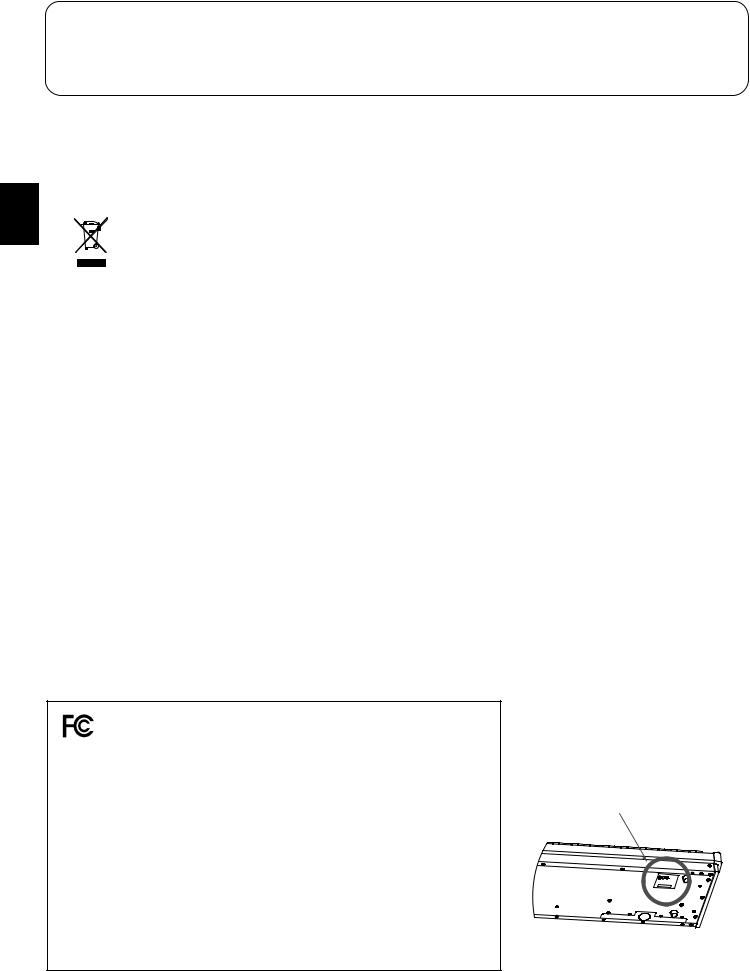
Important Information
The product should be serviced by quali ed service personnel when:
●The power supply cord or the plug has been damaged.
●Objects have fallen, or liquid has been spilled into the product.
●The product has been exposed to rain.
●The product does not appear to operate normally or exhibits a marked change in performance. ●The product has been dropped, or the enclosure damaged.
Notes on Repair
Should an abnormality occur in the product, immediately turn the power OFF, disconnect the power cord plug, and then contact the shop from which the product was purchased.
CAUTION:
To prevent electric shock, match wide blade of plug to wide slot, fully insert.
ATTENTION:
Pour éviter les chocs électriques, introduire la lame la plus large de la che dans la borne correspondante de la prise et pousser jusqu'au fond.
An information on Disposal for users
If your product is marked with this recycling symbol it means that, at the end of its life, you must dispose of it separately by taking it to an appropriate collection point.
You should not mix it with general household waste. Disposing of this product correctly will prevent potential negative e ects on the environment and human health which could otherwise arise due to inappropriate waste handling.
For further details, please contact your local authority. (European Union only)
Instruction for AC power cord (U.K.)
IMPORTANT
THE WIRES IN THIS MAINS LEAD ARE COLOURED IN ACCORDANCE WITH THE FOLLOWING CODE.
BLUE : NEUTRAL
BROWN : LIVE
As the colours of the wires in the mains lead of this apparatus may not correspond with the coloured markings identifying the terminals in your plug, proceed as follows:
The wire which is coloured BLUE must be connected to the terminal which is marked with the letter N or coloured BLACK. The wire which is coloured BROWN must be connected to the terminal which is marked with the letter L or coloured RED. Do not plug either terminal of the power cord to the the ground AC outlet on the wall.
Canadian Radio Interference Regulations
This instrument complies with the limits for a class B digital apparatus, pursuant to the Radio Interference Regulations, C.R.C., c. 1374.
FCC Information (U.S.A)
CAUTION : Changes or modi cations not expressly approved by the party responsible for compliance could void the user’s authority to operate the equipment.
NOTE : This equipment has been tested and found to comply with the limits for a Class B digital device, pursuant to Part 15 of the FCC Rules. These limits are designed to provide reasonable protection against harmful interference in a residential installation. This equipment generates, uses and can radiate radio frequency energy and, if not installed and used in accordance with the instructions, may cause harmful interference to radio communications. However, there is no guarantee that interference will not occur in a particular installation. If this equipment does cause harmful interference to radio or television reception, which can be determined by turning the equipment o and on, the user is encouraged to try to correct the interference by one or more of the following measures:
Reorient or relocate the receiving antenna.
Increase the separation between the equipment and receiver.
Connect the equipment into an outlet on a circuit di erent from that to which the receiver is connected.
Consult the dealer or an experienced radio/TV technician for help.
Declaration of Conformity
Products : |
Electronic Piano |
Model Number : |
ES920 |
Responsible Party Name : |
Kawai America Corporation |
Address : |
2055 East University Drive Rancho |
|
Dominguez, CA 90220 |
Telephone |
310-631-1771 |
This device complies with Part 15 of the FCC Rules. Operation is subject to the following two conditions:
(1)this device may not cause harmful interference, and
(2)this device must accept any interference received, including interference that may cause undesired operation.
This applies only to products distributed by Kawai America Corporation.
The nameplate label is located on the underside of the instrument, as indicated below.
Nameplate
6
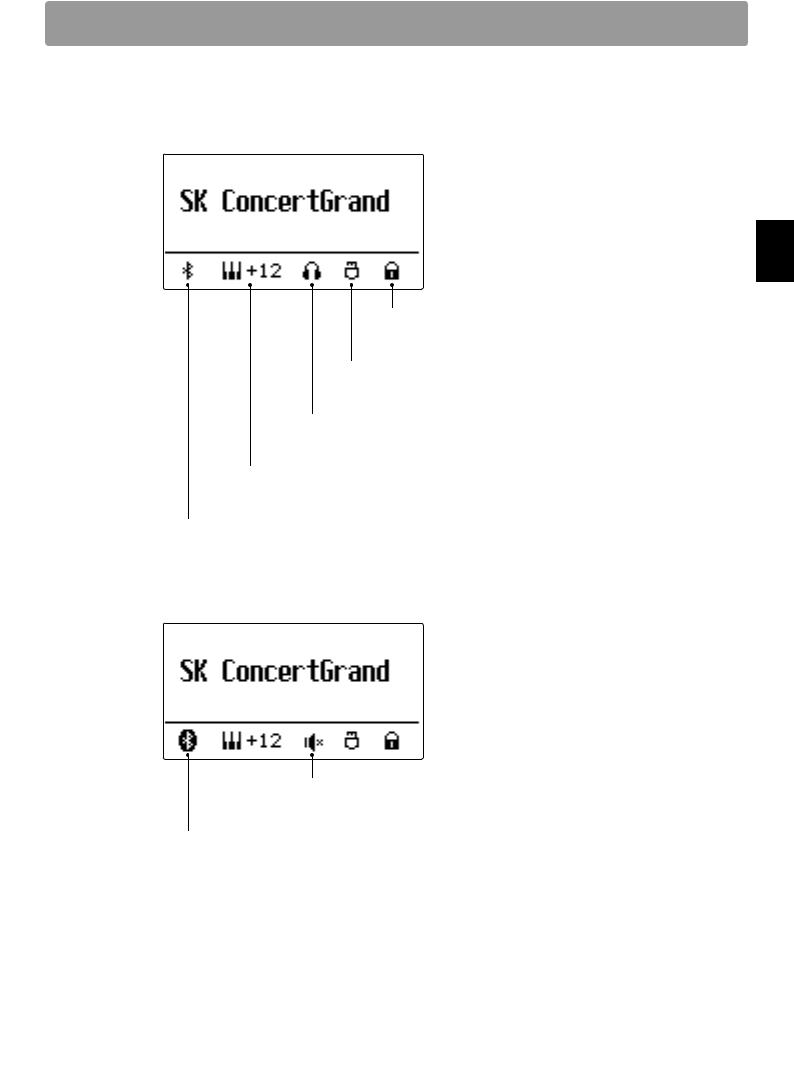
Displayed Icons
Panel lock icon
Displayed when panel lock is on.
USB icon
Displayed when a USB memory device is connected.
Headphone icon
Displayed when a pair of headphones is connected.
Transpose icon
Displayed when key TRANSPOSE is on.
Bluetooth icon
Displayed when Bluetooth Audio or Bluetooth MIDI is on.
* Displayed when the SPEAKER switch is off.
(Headphone icon is displayed when a pair of headphones is connected)
* Displayed when a Bluetooth connection is made.
Important Information
7

Important Information
of C |
|
|
Table ofContents |
|
|
Important Information |
|
|
Important Safety Instructions.. . . . . . . . . . . . . . . . . . . . . . |
. 3 |
|
Displayed Icons .. . . . . . . . . . . . . . . . . . . . . . . . . . . . . . . . . . . . . . |
7 |
|
Table of Contents.. .. .. .. .. .. .. .. .. .. .. .. .. .. .. .. .. .. .. .. .. .. .. .. .. .. .. .. .. .. .. .. .. .. .. .. |
.. 8 |
|
Welcome to the Kawai ES920.. . . . . . . . . . . . . . . . . . . . . . . |
10 |
|
1. |
Package Contents .. . . . . . . . . . . . . . . . . . . . . . . . . . . . |
10 |
2. |
Feature Highlights.. . . . . . . . . . . . . . . . . . . . . . . . . . . . |
11 |
Part Names and Functions.. . . . . . . . . . . . . . . . . . . . . . . . . . |
12 |
|
Preparation |
|
|
Setting Up the Piano.. . . . . . . . . . . . . . . . . . . . . . . . . . . . . . . . |
14 |
|
Basic Operation.. . . . . . . . . . . . . . . . . . . . . . . . . . . . . . . . . . . . . |
15 |
|
Basic Operation |
|
|
Selecting Sounds. . . . . . . . . . . . . . . . . . . . . . . . . . . . . . . . . . . . |
16 |
|
Demo Songs.. . . . . . . . . . . . . . . . . . . . . . . . . . . . . . . . . . . . . . . . |
17 |
|
Dual Mode. . . . . . . . . . . . . . . . . . . . . . . . . . . . . . . . . . . . . . . . . . . |
18 |
|
Split Mode.. . . . . . . . . . . . . . . . . . . . . . . . . . . . . . . . . . . . . . . . . . |
20 |
|
Four Hands Mode.. . . . . . . . . . . . . . . . . . . . . . . . . . . . . . . . . . . |
22 |
|
Enhancing the Sound.. . . . . . . . . . . . . . . . . . . . . . . . . . . . . . . |
24 |
|
1. |
Reverb.. . . . . . . . . . . . . . . . . . . . . . . . . . . . . . . . . . . . . . . . |
24 |
2. |
Effects .. . . . . . . . . . . . . . . . . . . . . . . . . . . . . . . . . . . . . . . . |
26 |
3. |
Amp Simulator.. .. .. .. .. .. .. .. .. .. .. .. .. .. .. .. .. .. .. .. .. .. .. .. .. .. .. .. .. .. .. .. |
29 |
4. |
Equaliser. . . . . . . . . . . . . . . . . . . . . . . . . . . . . . . . . . . . . . |
30 |
Panel Lock.. . . . . . . . . . . . . . . . . . . . . . . . . . . . . . . . . . . . . . . . . . . |
31 |
|
Transpose .. . . . . . . . . . . . . . . . . . . . . . . . . . . . . . . . . . . . . . . . . . . |
32 |
|
Metronome. . . . . . . . . . . . . . . . . . . . . . . . . . . . . . . . . . . . . . . . . . |
34 |
|
Registration Memories.. . . . . . . . . . . . . . . . . . . . . . . . . . . . . |
36 |
|
Rhythm Section Basic Operation.. . . . . . . . . . . . . . . . . . . |
38 |
|
Rhythm Section Style.. . . . . . . . . . . . . . . . . . . . . . . . . . . . . |
40 |
|
Rhythm Section Parts.. . . . . . . . . . . . . . . . . . . . . . . . . . . . . |
41 |
|
Song Recorder (Internal memory).. . . . . . . . . . . . . . . . . . . . . . . . |
42 |
|
1. |
Recording a Song. . . . . . . . . . . . . . . . . . . . . . . . . . . . . |
42 |
2. |
Playing a Song. . . . . . . . . . . . . . . . . . . . . . . . . . . . . . . . |
44 |
3. |
Recording a Song with the Rhythm Section.. . . |
46 |
4. |
Erasing a Part/Song.. . . . . . . . . . . . . . . . . . . . . . . . . . |
47 |
Audio Record/Playback (USB memory).................. |
48 |
|
1. |
Recording an Audio file.. . . . . . . . . . . . . . . . . . . . . . |
48 |
2. |
Playing an Audio file. . . . . . . . . . . . . . . . . . . . . . . . . . |
50 |
3. |
Overdubbing an Audio file .. . . . . . . . . . . . . . . . . . . |
52 |
4. |
Playing a MIDI file. . . . . . . . . . . . . . . . . . . . . . . . . . . . . |
54 |
5. |
Converting a MIDI file to an Audio file.. . . . . . . . |
56 |
6. |
Recording an Audio file |
|
|
with the Rhythm Section.. . . . . . . . . . . . . . . . . . . . . |
58 |
7. |
Converting a Song to an Audio file.. . . . . . . . . . . |
59 |
8. |
Deleting an Audio/MIDI file. . . . . . . . . . . . . . . . . . . |
60 |
USB Menu.. . . . . . . . . . . . . . . . . . . . . . . . . . . . . . . . . . . . . . . . . . . |
61 |
|
1. |
Load Internal Song .. . . . . . . . . . . . . . . . . . . . . . . . . . . |
62 |
2. |
Load Registration. . . . . . . . . . . . . . . . . . . . . . . . . . . . . |
63 |
3. |
Load Startup Setting.......................... |
64 |
4. |
Save SMF Song .. . . . . . . . . . . . . . . . . . . . . . . . . . . . . . . |
65 |
5. |
Save Internal Song. . . . . . . . . . . . . . . . . . . . . . . . . . . . |
66 |
6. |
Save Registration.. . . . . . . . . . . . . . . . . . . . . . . . . . . . . |
67 |
7. |
Save Startup Setting. . . . . . . . . . . . . . . . . . . . . . . . . . |
68 |
8. |
Rename File................................... |
69 |
9. |
Delete File.. . . . . . . . . . . . . . . . . . . . . . . . . . . . . . . . . . . . |
70 |
10. Format USB.. . . . . . . . . . . . . . . . . . . . . . . . . . . . . . . . . . . |
71 |
|
Adjustments & Settings |
|
|
Settings Menus. . . . . . . . . . . . . . . . . . . . . . . . . . . . . . . . . . . . . . |
72 |
|
Basic Settings .. . . . . . . . . . . . . . . . . . . . . . . . . . . . . . . . . . . . . . . |
73 |
|
1-1. Tone Control. . . . . . . . . . . . . . . . . . . . . . . . . . . . . . . . . . |
74 |
|
|
Brilliance. . . . . . . . . . . . . . . . . . . . . . . . . . . . . . . . . . . . . . |
74 |
|
User EQ.. . . . . . . . . . . . . . . . . . . . . . . . . . . . . . . . . . . . . . . |
75 |
1-2. Wall EQ .. . . . . . . . . . . . . . . . . . . . . . . . . . . . . . . . . . . . . . . |
76 |
|
1-3. Speaker Volume.. . . . . . . . . . . . . . . . . . . . . . . . . . . . . . |
76 |
|
1-4. Low Volume Balance. . . . . . . . . . . . . . . . . . . . . . . . . . |
77 |
|
1-5. Line Out Volume. . . . . . . . . . . . . . . . . . . . . . . . . . . . . . |
78 |
|
1-6. Audio Recorder Gain.......................... |
78 |
|
1-7. Tuning.. . . . . . . . . . . . . . . . . . . . . . . . . . . . . . . . . . . . . . . . |
79 |
|
1-8. Damper Hold.. . . . . . . . . . . . . . . . . . . . . . . . . . . . . . . . . |
79 |
|
1-9. GFP-3 Mode .. . . . . . . . . . . . . . . . . . . . . . . . . . . . . . . . . . |
80 |
|
1-10. Four Hands.. . . . . . . . . . . . . . . . . . . . . . . . . . . . . . . . . . |
81 |
|
8

1-11. Startup Setting. . . . . . . . . . . . . . . . . . . . . . . . . . . . . . |
82 |
1-12. Factory Reset. . . . . . . . . . . . . . . . . . . . . . . . . . . . . . . . |
83 |
1-13. Auto Display Off.. . . . . . . . . . . . . . . . . . . . . . . . . . . . |
84 |
1-14. Auto Power Off. . . . . . . . . . . . . . . . . . . . . . . . . . . . . . |
85 |
Virtual Technician.. . . . . . . . . . . . . . . . . . . . . . . . . . . . . . . . . . |
. 86 |
2-1. Touch Curve.. . . . . . . . . . . . . . . . . . . . . . . . . . . . . . . . . |
. 88 |
2-2. Voicing........................................ |
90 |
User Voicing.. . . . . . . . . . . . . . . . . . . . . . . . . . . . . . . . . |
. 91 |
2-3. Damper Resonance. . . . . . . . . . . . . . . . . . . . . . . . . . . |
92 |
2-4. Damper Noise.. . . . . . . . . . . . . . . . . . . . . . . . . . . . . . . |
. 92 |
2-5. String Resonance.. . . . . . . . . . . . . . . . . . . . . . . . . . . . . |
93 |
2-6. Undamped String Resonance .. . . . . . . . . . . . . . . |
. 94 |
2-7. Cabinet Resonance.. . . . . . . . . . . . . . . . . . . . . . . . . . |
. 95 |
2-8. Key-off Effect.. . . . . . . . . . . . . . . . . . . . . . . . . . . . . . . . |
. 96 |
2-9. Fall-back Noise. . . . . . . . . . . . . . . . . . . . . . . . . . . . . . . . |
97 |
2-10. Hammer Noise.. . . . . . . . . . . . . . . . . . . . . . . . . . . . . |
. 97 |
2-11. Hammer Delay.. . . . . . . . . . . . . . . . . . . . . . . . . . . . . |
. 98 |
2-12. Topboard. . . . . . . . . . . . . . . . . . . . . . . . . . . . . . . . . . . . |
99 |
2-13. Decay Time. . . . . . . . . . . . . . . . . . . . . . . . . . . . . . . . . |
100 |
2-14. Release Time.. . . . . . . . . . . . . . . . . . . . . . . . . . . . . . . |
100 |
2-15. Minimum Touch. . . . . . . . . . . . . . . . . . . . . . . . . . . . |
101 |
2-16. Temperament.. . . . . . . . . . . . . . . . . . . . . . . . . . . . . . |
102 |
Stretch Tuning.. . . . . . . . . . . . . . . . . . . . . . . . . . . . . . . |
103 |
Stretch Curve.. . . . . . . . . . . . . . . . . . . . . . . . . . . . . . . . |
104 |
User Tuning. . . . . . . . . . . . . . . . . . . . . . . . . . . . . . . . . . |
104 |
Temperament Key.. . . . . . . . . . . . . . . . . . . . . . . . . . . |
105 |
User Temperament.. . . . . . . . . . . . . . . . . . . . . . . . . . |
105 |
2-17. User Key Volume.. . . . . . . . . . . . . . . . . . . . . . . . . . . |
106 |
2-18. Half-Pedal Adjust. . . . . . . . . . . . . . . . . . . . . . . . . . . |
107 |
2-19. Soft Pedal Depth.. . . . . . . . . . . . . . . . . . . . . . . . . . . |
107 |
Key Settings.. . . . . . . . . . . . . . . . . . . . . . . . . . . . . . . . . . . . . . . . |
108 |
3-1. Lower Octave Shift.. .. .. .. .. .. .. .. .. .. .. .. .. .. .. .. .. .. .. .. .. .. .. .. .. .. .. |
109 |
3-2. Lower Pedal.................................. |
110 |
3-3. Split Balance.. . . . . . . . . . . . . . . . . . . . . . . . . . . . . . . . . |
110 |
3-4. Layer Octave Shift.. . . . . . . . . . . . . . . . . . . . . . . . . . . |
111 |
3-5. Layer Dynamics.. . . . . . . . . . . . . . . . . . . . . . . . . . . . . |
112 |
3-6. Dual Balance. . . . . . . . . . . . . . . . . . . . . . . . . . . . . . . . . |
112 |
Rhythm Section Settings. . . . . . . . . . . . . . . . . . . . . . . . . . . |
113 |
4-1. Rhythm Volume.. .. .. .. .. .. .. .. .. .. .. .. .. .. .. .. .. .. .. .. .. .. .. .. .. .. .. .. .. .. |
114 |
4-2. Auto Fill-in.. . . . . . . . . . . . . . . . . . . . . . . . . . . . . . . . . . . |
114 |
4-3. One Finger Ad-lib. . . . . . . . . . . . . . . . . . . . . . . . . . . . |
115 |
4-4. ACC Mode.. . . . . . . . . . . . . . . . . . . . . . . . . . . . . . . . . . . |
116 |
4-5. Bass Inversion................................ |
118 |
4-6. Preset Chord. . . . . . . . . . . . . . . . . . . . . . . . . . . . . . . . . |
119 |
Phones Settings.. . . . . . . . . . . . . . . . . . . . . . . . . . . . . . . . . . . . |
120 |
5-1. SHS Mode.................................... |
121 |
5-2. Phones Type.. . . . . . . . . . . . . . . . . . . . . . . . . . . . . . . . . |
122 |
5-3. Phones Volume.. . . . . . . . . . . . . . . . . . . . . . . . . . . . . . |
123 |
MIDI Settings. . . . . . . . . . . . . . . . . . . . . . . . . . . . . . . . . . . . . . . |
124 |
Bluetooth Settings.. . . . . . . . . . . . . . . . . . . . . . . . . . . . . . . . . |
124 |
7-1. Bluetooth Audio.. . . . . . . . . . . . . . . . . . . . . . . . . . . . . |
125 |
7-2. Bluetooth Audio Volume .. . . . . . . . . . . . . . . . . . . . |
126 |
7-3. Bluetooth MIDI .. . . . . . . . . . . . . . . . . . . . . . . . . . . . . . |
127 |
Appendix |
|
Connecting to Other Devices.. . . . . . . . . . . . . . . . . . . . . . |
128 |
Rear Connectors.. . . . . . . . . . . . . . . . . . . . . . . . . . . . . . . . . |
129 |
Upper Connectors .. . . . . . . . . . . . . . . . . . . . . . . . . . . . . . . |
129 |
Front Connectors .. . . . . . . . . . . . . . . . . . . . . . . . . . . . . . . . |
129 |
USB MIDI (USB to Host Connector) .. . . . . . . . . . . . . . . . . . . . . . . . |
130 |
Information about Bluetooth®. . . . . . . . . . . . . . . . . . . . . |
131 |
Troubleshooting.. . . . . . . . . . . . . . . . . . . . . . . . . . . . . . . . . . . |
132 |
Demo Song List .. . . . . . . . . . . . . . . . . . . . . . . . . . . . . . . . . . . . |
133 |
Rhythm Section Style List. . . . . . . . . . . . . . . . . . . . . . . . . . |
134 |
Rhythm Section Chord Types.. . . . . . . . . . . . . . . . . . . . . . |
135 |
Rhythm Section Preset Chord Sequences.. . . . . . . . . |
139 |
EU Declaration of Conformity. . . . . . . . . . . . . . . . . . . . . . |
141 |
Kawai ES920 Specifications.. . . . . . . . . . . . . . . . . . . . . . . . |
142 |
Owner’s Manual Conventions. . . . . . . . . . . . . . . . . . . . . . |
143 |
Important Information
9
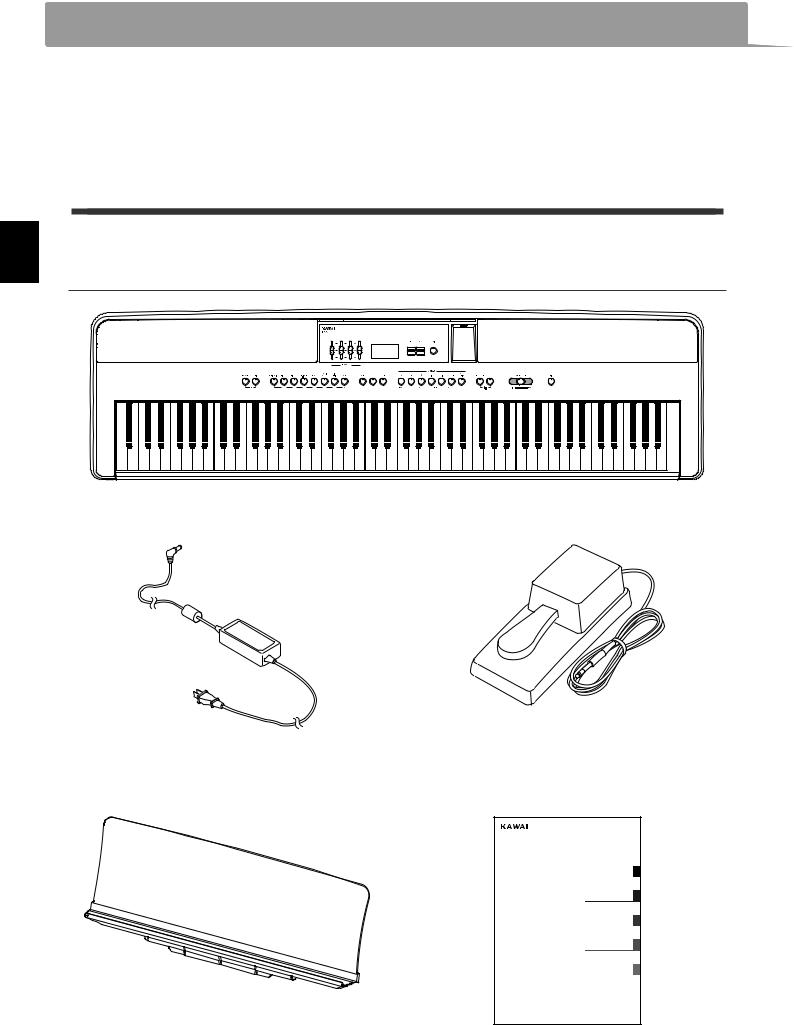
Welcometo thetoKawaitheES920Kawai ES920
Thank you for purchasing this Kawai ES920 digital piano.
This owner’s manual contains important information regarding the usage and operation of the ES920 digital piano. Please read all sections carefully, keeping this manual handy for future reference.
1 Package Contents
The Kawai ES920 digital piano package contains the following items:
ES920 digital piano
Important Information
AC power adaptor (PS-154) |
Foot pedal (F-10H) |
|
|
|
|
Music rack/rest |
Owner’s manual |
|
|
|
|
Important Information
Preparation
ES920
|
Owner’s Manual |
Basic Operation |
|
|
|
|
|
Adjustments & Settings |
|
|
Appendix |
|
|
|
|
|
10
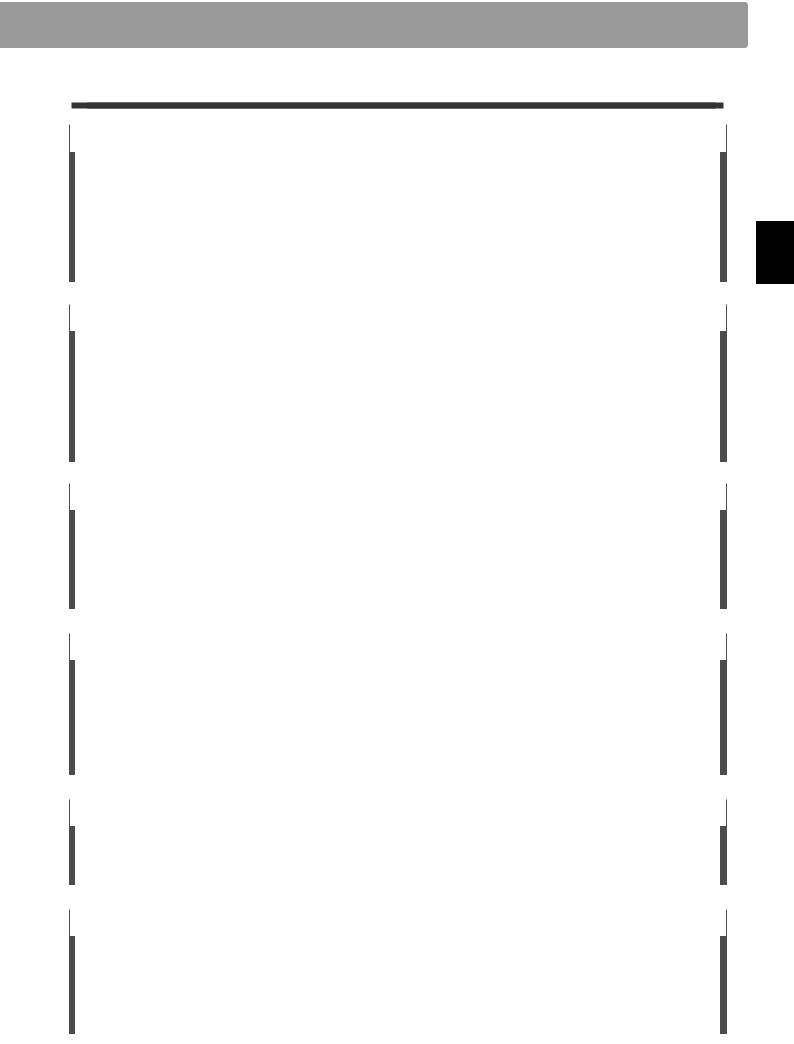
2 Feature Highlights
“Responsive Hammer III” weighted-key action, with Ivory Touch key surfaces and Let-off simulation
The new Responsive Hammer III (RHIII) action recreates the distinctive touch of an acoustic grand piano, with its realistic movement and accurate 3-sensor technology providing a smooth, natural, and highly responsive piano playing experience. The weight of the keyboard is appropriately graded to mirror the heavier bass hammers and lighter treble hammers of an acoustic piano, while structural reinforcements within the action assembly ensure greater stability during fortissimo and staccato passages.
The ES920 digital piano also features Kawai’s Ivory Touch key surfaces that gently absorb finger moisture to assist the player’s performance, while, let-off simulation recreates the subtle “notch” sensation felt when softly playing the keys of a grand piano, satisfying the expectations of the most discerning pianists.
Shigeru Kawai SK-EX, SK-5, and Kawai EX instruments reproduced with Harmonic Imaging sound technology
The ES920 digital piano captures the rich, expressive sound of the Kawai SK-EX, SK-5, and EX grand pianos, with all 88 keys of these exceptional instruments meticulously recorded, analysed and faithfully reproduced using Harmonic Imaging™ sound technology. This unique process accurately recreates the broad dynamic range of the original grand pianos, affording pianists an extraordinary level of expressiveness ranging from the softest pianissimo to the strongest, boldest fortissimo.
The instrument’s built-in Virtual Technician feature allows various characteristics of these acoustic piano sounds to be shaped at the touch of a button, with settings to adjust string and damper resonance, in addition to subtle hammer, damper, and key release noises. This personalised piano sound is further enhanced with atmospheric reverberation effects, delivering a rich, vibrant piano tone with breathtaking realism and authenticity.
Strong selection of additional instrument sounds
Supplementing the realistic acoustic piano voices, the ES920 digital piano also features a strong selection of additional instrument sounds, ranging from electric pianos and drawbar and church organs, to string, choir, and mallet instruments, inviting musicians to add greater variety to their performances.
Furthermore, the Dual playing mode also allows two different sounds, such as grand piano and strings, to be layered together, while the Split and Four Hands modes divide the keyboard into two independent sections. The volume balances for each playing mode can also be adjusted quickly and easily using the real-time panel controls.
USB to Device functionality, with MP3/WAV file recording and playback
The ES920 digital piano is equipped with USB connectors that not only allow the instrument to be connected to a computer for MIDI use, but also to load and save data to USB memory devices directly. This USB to Device feature allows registration memories and songs recorded and stored in internal memory to be saved to USB for posterity, or standard MIDI files (SMF) downloaded from the internet to be conveniently played back without additional hardware.
USB memory devices can also be used to play back MP3 or WAV audio files, allowing musicians to learn the chords or melody for a new piece, or to simply play along with their favourite songs. It is even possible to save performances as MP3 or WAV files for emailing to friends and family, listening to on a smartphone, or for further editing using an audio workstation.
Wide range of connectivity options
The ES920 digital piano features a variety of standard connectivity options, with Line-level output jacks that allow the instrument to be enjoyed in larger settings such as churches and schools. Standard MIDI and USB to Host connectors ensure flexibility when using computers and other electronic instruments, while the Line-in stereo jack provides a convenient method of mixing in audio from a laptop, tablet, or other digital device.
Integrated Bluetooth® MIDI connectivity
In addition to standard MIDI jacks for connecting to other instruments, the ES920 digital piano also boasts integrated Bluetooth MIDI and Audio technology that allows the instrument to communicate with supported smart devices wirelessly. Once connected to a phone, tablet, or laptop, ES920 digital piano owners can enjoy a wide variety of exciting music-related apps that enhance their learning and playing experience, or stream audio from songs and videos through the instrument’s speakers without additional cables.
* Availability of Bluetooth function dependent on market location.
11
Important Information
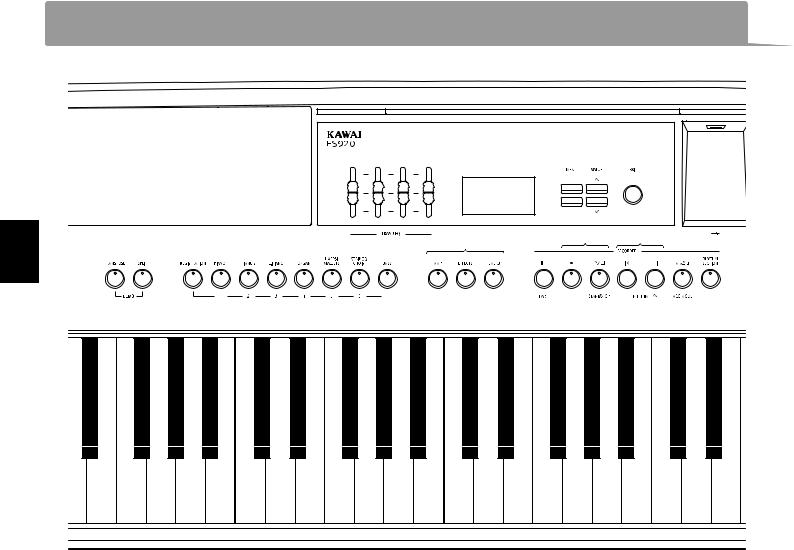
PartNamesand Functionsand Functions
Important Information
F |
A |
|
|
C D |
E |
|
|
|
B |
|
|
|
K |
L |
M |
N |
O |
P Q |
|
|
G H J 


I
A4-band equaliser |
GTRANSPOSE button |
The equaliser is used to adjust the volume of the low, mid-low, mid-high, and high frequency bands.
This button is used to adjust the pitch of the instrument’s keyboard in semi-tone steps.
BDisplay
The display provides important information relating to the currently selected sound, style, function, and setting.
*A protective plastic film is attached to the display during production. Please remove this film before attempting to play the instrument.
CMENU buttons
These buttons are used to navigate through the instrument’s various function and settings menus.
DVALUE buttons
These buttons are used to adjust values, and change settings etc.
EEXIT button
This button is used to exit the current function, or return to the previous screen.
FUSB to Device port (Type A)
This port is used to connect a FAT or FAT32 formatted USB memory device to the instrument in order to load/save recorded song data, registration memories, and MP3/WAV/SMF files etc.
*Use this port for connecting USB memory devices only.
*Connect the USB memory device directly, without using a USB extension 12 cable.
HSPLIT button
This button is used to select and adjust the instrument’s Split/ Four Hands mode functions.
IDEMO button
When pressed simultaneously, the TRANSPOSE and SPLIT buttons are also used to select the instrument’s Demo mode.
JREGISTRATION button
This button is used to store and recall one of the 28 different Registration memories. Each Registration can store sound, Rhythm Section, reverb/effects, and Virtual Technician settings, as well as various other panel and menu options.
KSOUND buttons
These buttons are used to select the sound(s) that will be heard when playing the instrument’s keyboard.
These buttons are also used to select Registration memories.
LAMP/EFFECTS/REVERB buttons
These buttons are used to turn the instrument’s amp, reverb, and effects functions on/off, and to adjust their various settings.
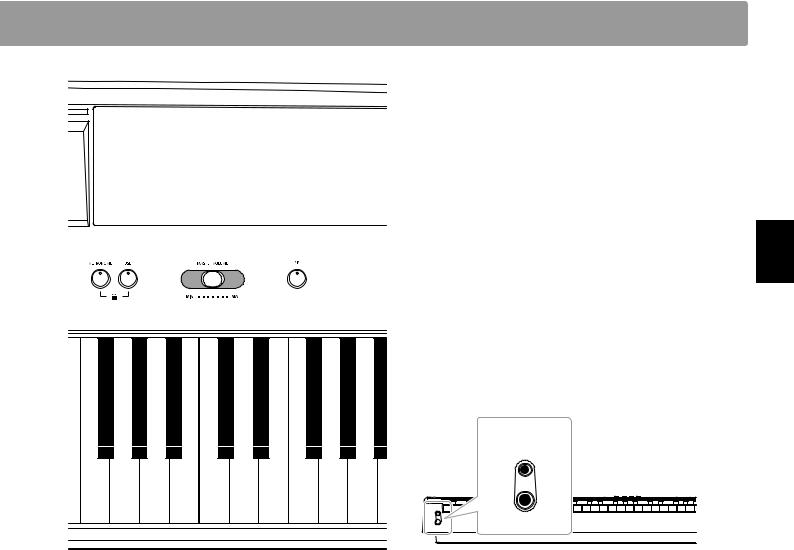
R S T U
V
Important Information
M (RESET/PART) button
(RESET/PART) button
This button is used to reset the instrument’s song recorder, and to rewind songs and MP3/WAV/SMF files to the beginning.
This button is also used to select the Rhythm Section part.
N (REC) and
(REC) and

 (PLAYBACK / START/STOP) buttons
(PLAYBACK / START/STOP) buttons
These buttons are used to record and playback songs stored in the instrument’s internal memory, or MP3/WAV/SMF files saved to a USB memory device.
O
 (REW) and
(REW) and
 (FWD) buttons
(FWD) buttons
These buttons are used to move the playing position of the current recorder song or MP3/WAV/SMF backward or forward. These buttons are also used to select the recorder song and Rhythm Section style.
P

 (LOOP) button
(LOOP) button
This button is used to enable the instrument’s A-B Loop function, allowing passages of a recorder song or MP3/WAV/SMF file to be played back repeatedly.
This button is also used to select the Rhythm Section ACC mode.
QRHYTHM SECTION button
This button is used to select the instrument’s Rhythm Section function, featuring drum rhythms and accompaniment styles.
RMETRONOME button
This button is used to turn the instrument’s metronome function on/off, and to adjust metronome settings.
SUSB button
This button is used to access the instrument’s USB functions.
When pressed simultaneously, the METRONOME and USB buttons are used to toggle the instrument’s Panel Lock feature.
TMASTER VOLUME slider
This slider controls the master volume level of the instrument’s built-in speakers or headphones, if connected.
*This slider affects the LINE OUT level. For information about adjusting the LINE OUT level, please refer to page 78.
UPOWER button
This button is used to turn the instrument on and off. Be sure to turn off the instrument after use.
*The ES920 digital piano features a power saving mode that can turn off the instrument automatically after a specified period of inactivity. For more information, please refer to the Auto Power Off setting on page 85.
VPHONES jacks
These jacks are used to connect stereo headphones to the instrument. Two pairs of headphones can be connected and used simultaneously.
* For more information about connectors/jacks, please refer to page 128. 13
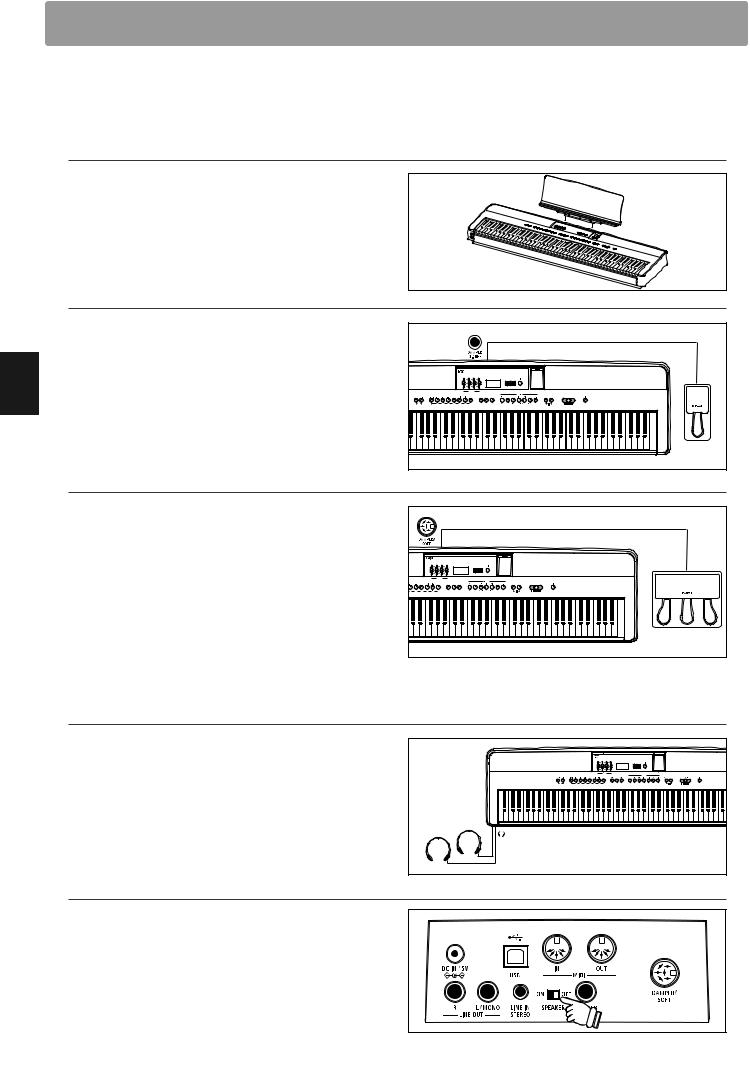
Preparation
Setting Up the Piano
Upon unboxing the instrument, please follow the instructions below which explain how to attach the music rest, connect the F-10H (or optional GFP-3) foot pedal, and if desired, connect a pair of headphones.
Attaching the music rest
Insert the base of the music rest into the groove located at the rear of the ES920 digital piano, taking care not to scratch the rear of the instrument.
To prevent possible damage, avoid applying excessive force when attaching/detaching the music rest from the instrument.
Connecting the F-10H foot pedal
Connect the included Kawai F-10H foot pedal to the DAMPER pedal jack located on the rear panel of the instrument.
The foot pedal will function as a damper pedal, sustaining the sound after hands are lifted from the keyboard. This pedal is capable of responding to “half pedaling”.
Connecting the optional GFP-3 triple pedal
Connect the optional Kawai GFP-3 triple pedal to the DAMPER/
SOFT pedal jack located on the rear panel of the instrument.
The right pedal will function as a damper pedal, sustaining the sound after hands are lifted from the keyboard. This pedal is also capable of responding to “half pedaling”.
The centre pedal will function as a sostenuto pedal, and the left pedal will function as a soft pedal.
* When “Jazz Organ”, “Drawbar Organ” or “Ballad Organ” sounds are selected, the soft pedal can also be used to alternate the speed of the rotary speaker effect between “Slow” and “Fast” modes.
Connecting headphones
Use the jacks located on either side of the keyboard to connect stereo headphones to the ES920 digital piano.
There are one standard jack and one mini jack so up to two pairs of headphones can be connected. When a pair of headphones is connected, sound will not be produced by the built-in speakers.
Turning built-in speakers on/off
Set the SPEAKER switch located on the rear panel to the Off position to disable the instrument’s built-in speakers. Set the switch to the On position to enable the speakers.
*When a pair of headphones is connected, sound will not be producedfrom the built-in speakers regardless of the status of the SPEAKER switch.
14
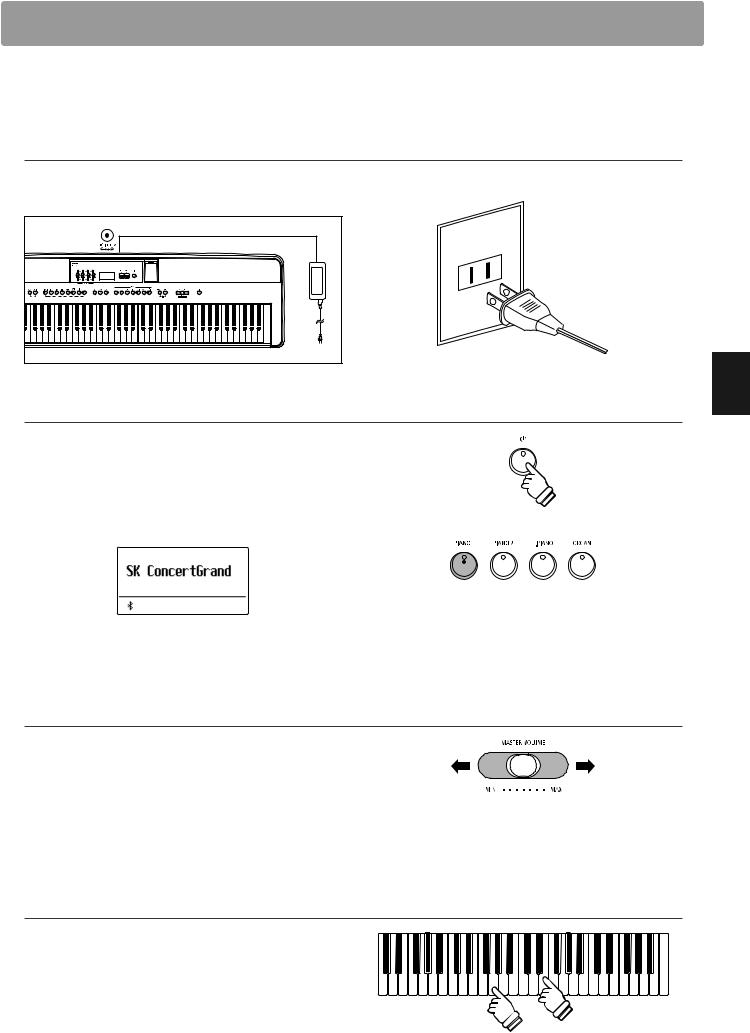
Basic Operation
The following instructions explain how to connect the instrument to the power outlet, turn on the power, adjust the volume to a comfortable level, and begin playing the piano.
1. Connecting the power adaptor
Connect the included AC power adaptor to the “DC IN” jack Connect the AC power adaptor to an AC outlet. located on the rear panel of the instrument, indicated below.
2. Turning on the instrument’s power
Press the POWER button located on the right side of the instrument’s control panel.
The instrument will turn on, and the words “SK ConcertGrand” will be shown in the display, indicating that the SK ConcertGrand sound is selected. The LED indicator for the PIANO 1 button will also turn on.
 LED indicator on:
LED indicator on:
Sound category is selected.
*The ES920 digital piano features a power saving mode that can turn off the instrument automatically after a specified period of inactivity. For more information, please refer to the Auto Power Off setting on page 85.
3. Adjusting the volume
The MASTER VOLUME slider controls the volume level of the |
Left: |
Right: |
||
instrument’s speakers, or headphones if connected. |
||||
Decrease |
Increase |
|||
|
||||
Move the slider to the right to increase the volume, and to the |
volume |
volume |
||
|
|
|
||
|
|
|
||
left to decrease the volume. |
|
|
|
|
Use this slider to set the volume to a comfortable listening level |
* This slider affects the LINE OUT level. For information about adjusting |
|||
- the middle is often a good starting point. |
the LINE OUT level, please refer to page 78. |
|
||
4. Play the piano
Begin playing the piano.
The rich sound of a Kawai SK-EX Concert Grand Piano will be heard as the keys are pressed.
Preparation
15
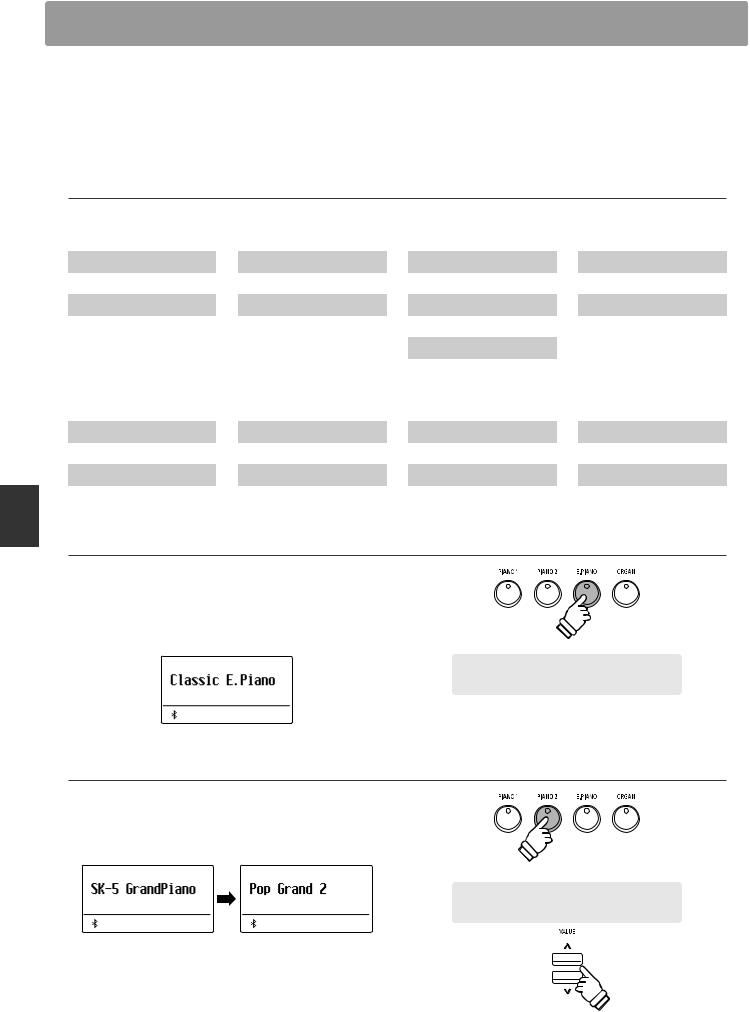
Basic Operation
Selecting Sounds
The ES920 digital piano features a wide selection of realistic instrument sounds suitable for various musical styles. Sounds are arranged into seven categories, with multiple sounds assigned to each category button.
By default, the “SK ConcertGrand” sound will be selected automatically when the instrument is turned on.
Sound categories and variations
PIANO 1 |
|
PIANO 2 |
|
E. PIANO |
|
ORGAN |
||||
|
|
|
|
|
|
|
|
|
|
|
1 |
SK ConcertGrand |
1 |
SK-5 GrandPiano |
1 |
Classic E.Piano |
1 |
Jazz Organ |
|||
2 |
EX ConcertGrand |
2 |
Upright Piano |
2 |
Classic E.P. 2 |
2 |
Drawbar Organ |
|||
3 |
Jazz Clean |
3 |
Pop Grand 2 |
3 |
Classic E.P. 3 |
3 |
Ballad Organ |
|||
4 |
Warm Grand |
4 |
Modern Piano |
4 |
60’s E.Piano |
4 |
Principal Oct. |
|||
5 |
Pop Grand |
5 |
Rock Piano |
5 |
60’s E.Piano 2 |
5 |
Church Organ |
|||
|
|
|
|
|
6 |
Modern E.Piano |
|
|
|
|
|
|
|
|
|
|
|
|
|||
|
|
|
|
|
|
|
|
|
|
|
HARPSI / MALLETS |
|
STRINGS / CHOIR |
|
|
|
BASS |
|||
|
|
|
|
|
|
|
|
|
|
1 |
Harpsichord |
1 |
String Ensemble |
5 |
Choir Ooh/Aah |
1 |
Electric Bass |
||
2 |
Vibraphone |
2 |
Slow Strings |
6 |
Pop Ensemble |
2 |
Electric Bass 2 |
||
3 |
Clavi |
3 |
String Pad |
7 |
Square Pad |
3 |
Electric Bass 3 |
||
4 |
Marimba |
4 |
Warm Strings |
8 |
New Age Pad |
4 |
Wood Bass |
||
|
|
|
|
|
|
|
5 |
W. Bass & Ride |
|
|
|
|
|
|
|
|
|
|
|
1. Selecting a sound category
Press the desired SOUND button.
The LED indicator for the button will turn on to indicate that this category has been selected, and the name of the sound will be shown in the display.
Example: To select the E.PIANO category, press the
E.PIANO button.
2. Changing the selected sound variation
Several sound variations are assigned to each category button.
Press a SOUND button repeatedly to cycle through the different sound variations.
× 3
Example: To select the “Pop Grand 2” sound, press the PIANO2 button three times.
The  or
or  VALUE buttons can also be used to select sounds, and cycle through the different sound variations.
VALUE buttons can also be used to select sounds, and cycle through the different sound variations.
16
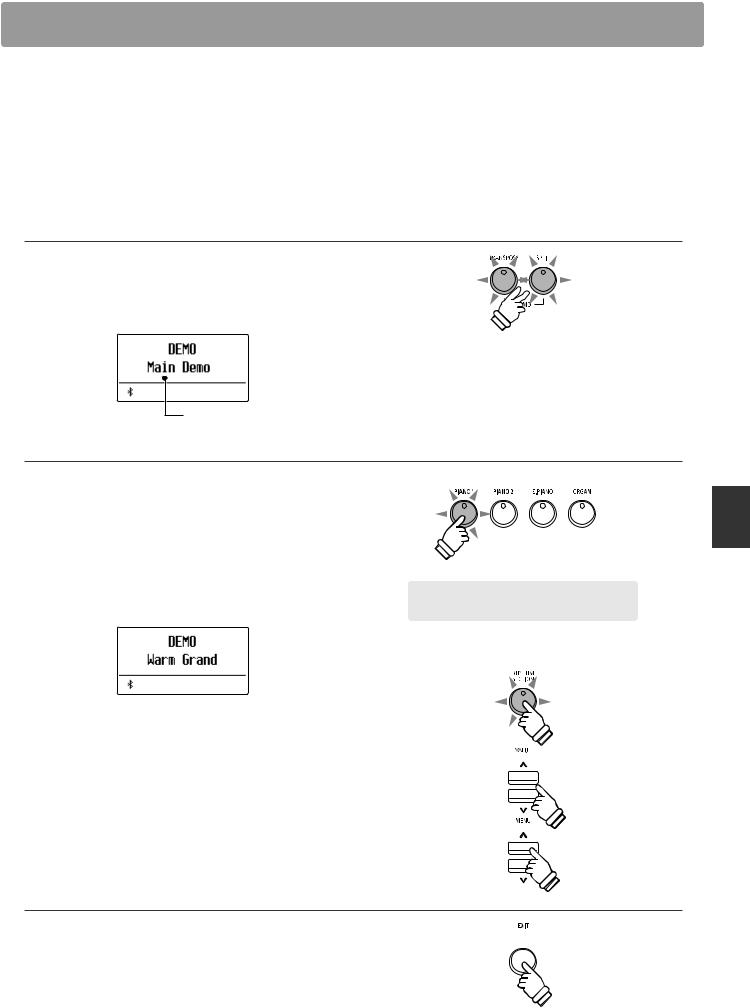
Demo Songs
The Demo function provides an excellent introduction to the varied capabilities of the ES920 digital piano.
There are 25 different demonstration songs available, highlighting the instrument’s rich selection of high quality sounds, convenient Rhythm Section feature, and powerful speaker system.
For a complete listing of the available demonstration songs, please refer to page 133 of this owner’s manual.
* Kawai regrets that sheet music for Kawai original demo songs is not available.
1. Entering demo mode
Press the TRANSPOSE and SPLIT buttons simultaneously.
The LED indicators for both buttons will start to flash to indicate that demo mode is in use, and the Main Demo song will start to play.
Demo song name
*When the Main Demo song has finished, a sound demo song will be selected at random, and will start to play.
*During demo mode, pedals connected to the ES920 will not be effective.
2. Selecting a demo song
While Demo mode is selected and the demo songs are playing:
Press the desired SOUND button.
The LED indicator for the button will start to flash, and the first demo in the selected sound category will start to play.
Press the selected sound category button repeatedly to cycle through the different demo songs in that category.
In addition, press the RHYTHM SECTION button to play the Rhythm Section demo song.
*When the Rhythm Section song has finished, the Main Demo song will be re-selected, and will start to play.
The  or
or  VALUE buttons can also be used to cycle through all of the different demo songs.
VALUE buttons can also be used to cycle through all of the different demo songs.
The  or
or  MENU buttons can be used to switch for each group.
MENU buttons can be used to switch for each group.
3. Stopping the demo song and exiting demo mode
× 4
Example: To select the Warm Grand demo song, press the PIANO1 button four times.
While Demo mode is selected and the demo songs are playing:
Press the EXIT button.
The LED indicators will stop flashing, the demo songs will stop playing, and the instrument will return to normal playing mode.
Basic Operation
17
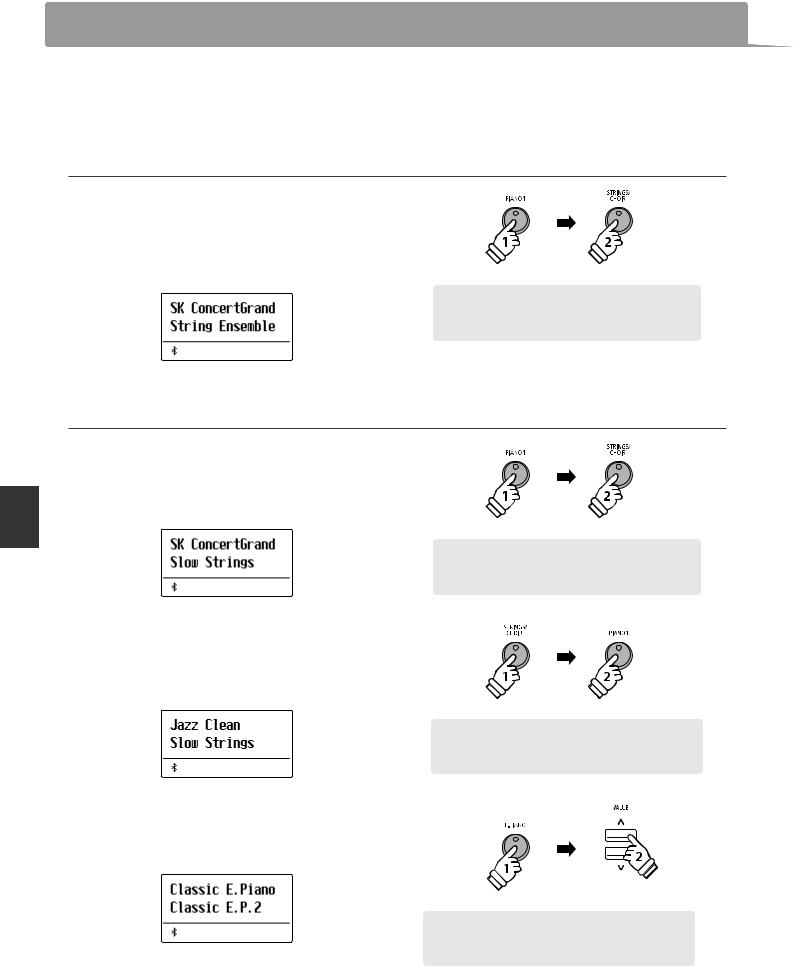
DualModeMode
The Dual Mode function allows two sounds to be layered together, creating a more complex sound. For example, a piano sound layered with strings, or a church organ combined with a choir, etc.
1. Entering Dual mode
Press and hold a SOUND button to select the main sound, then press another SOUND button to select the layered sound.
The LED indicators for both SOUND buttons will turn on to indicate that Dual mode is in use, and the respective sound names will be shown in the display.
Main sound
Layered sound
hold
Example: To layer the “Slow Strings” sound with the “SK ConcertGrand” sound, press and hold the PIANO1 button, then press the STRINGS/CHOIR button.
2. Changing the main/layered sounds
To select a different variation for the layered sound:
Press and hold the main SOUND button, then press the layered SOUND button repeatedly to cycle through the different sound variations.
Operation |
To select a different variation for the main sound: |
Basic |
Press and hold the layered SOUND button, then press the main |
|
|
|
SOUND button repeatedly to cycle through the different sound |
|
variations. |
To layer two variations assigned to the same SOUND button:
Press and hold a SOUND button, then press the  or
or  VALUE buttons to select the layered sound variation.
VALUE buttons to select the layered sound variation.
*Preferred Dual mode sound combinations can be stored to a Registration memory for convenient recall. Please refer to page 36 for more information.
hold
Example: To change the layered “String Ensemble” sound to the “Slow Strings” sound, press and hold the PIANO1 button, then press the STRINGS/CHOIR button.
hold |
2 |
|
× |
Example: To change the main “SK ConcertGrand” sound to the “Jazz Clean” sound, press and hold the STRINGS/CHOIR button, then press the PIANO1 button twice.
|
2 |
hold |
× |
|
Example: To layer the “Classic E.P.” and “60’s E.Piano” sounds together, press and hold the E.PIANO button, then press the VALUE button twice.
button twice.
18

3. Adjusting the main/layered sound volume balance
While Dual mode is in use:
Press the  or
or  VALUE buttons to adjust the volume balance between the main and layered sounds.
VALUE buttons to adjust the volume balance between the main and layered sounds.
The volume balance will briefly be shown in the display.
* The default Dual mode volume balance is 9-9.
*The preferred Dual mode volume balance can also be stored to a Registration memory for convenient recall. Please refer to page 36 for more information.
*The Layer Octave Shift setting can be used to adjust the octave range of the layered sound. Please refer to page 111 for more information.
*The Layer Dynamics setting can be used to adjust the dynamic sensitivity of the layered sound. Please refer to page 112 for more information.
VALUE |
|
Increase main |
VALUE |
sound volume/ |
Increase layered |
decrease layered |
sound volume/ |
sound volume. |
decrease main |
|
sound volume. |
5 ×
Example: To decrease the volume of the main sound to 5, press the VALUE  button five times.
button five times.
4. Exiting Dual mode
While Dual mode is in use:
Press a single SOUND button.
The LED indicator for the button will turn on, the name of the selected sound will be shown in the display, and the instrument will return to normal (single voice mode) operation.
Basic Operation
19
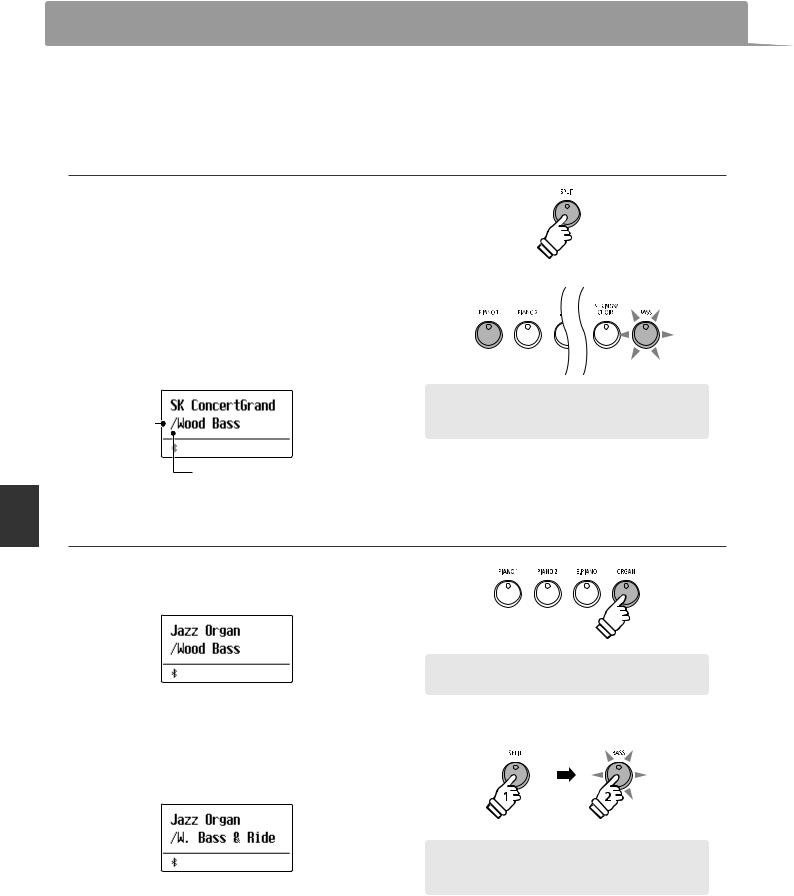
Basic Operation
SplitModeMode
The Split Mode function divides the keyboard into two sections, allowing each section to be played with a different sound. For example, a bass sound in the lower section, and a piano sound in the upper section.
1. Entering Split mode
Press the SPLIT button.
The LED indicator for the SPLIT button will turn on and the keyboard is split at the point between F#3 and G3.
G3 where the upper section begins, is called the split point.
The default split point is G3.
The LED indicator for the upper section sound button will turn on, and the LED indicator for the lower section sound button will start to flash. The respective sound names will also be shown in the display.
Upper section sound
Lower section |
sound |
Default Split mode:
The previously selected sound is used for the upper section, and the “Wood Bass” sound is selected for the lower section.
Split enabled
2. Changing the upper/lower section sounds
To select a different sound for the upper section:
Press the desired SOUND button.
To select a different sound for the lower section:
Press and hold the SPLIT button, then press the desired SOUND button.
*The Lower Octave Shift setting can be used to adjust the octave range of the lower section. Please refer to page 109 for more information.
*The Lower Pedal setting can be used to enable/disable the damper pedal for the lower section. Please refer to page 110 for more information.
*Preferred Split mode upper/lower sound combinations can be stored to a Registration memory for convenient recall. Please refer to page 36 for more information.
Example: To select the “Jazz Organ” sound for the upper section, press the ORGAN button.
hold
Example: To select the “W. Bass & Ride” sound for the lower section, press and hold the SPLIT button, then press the BASS button.
20
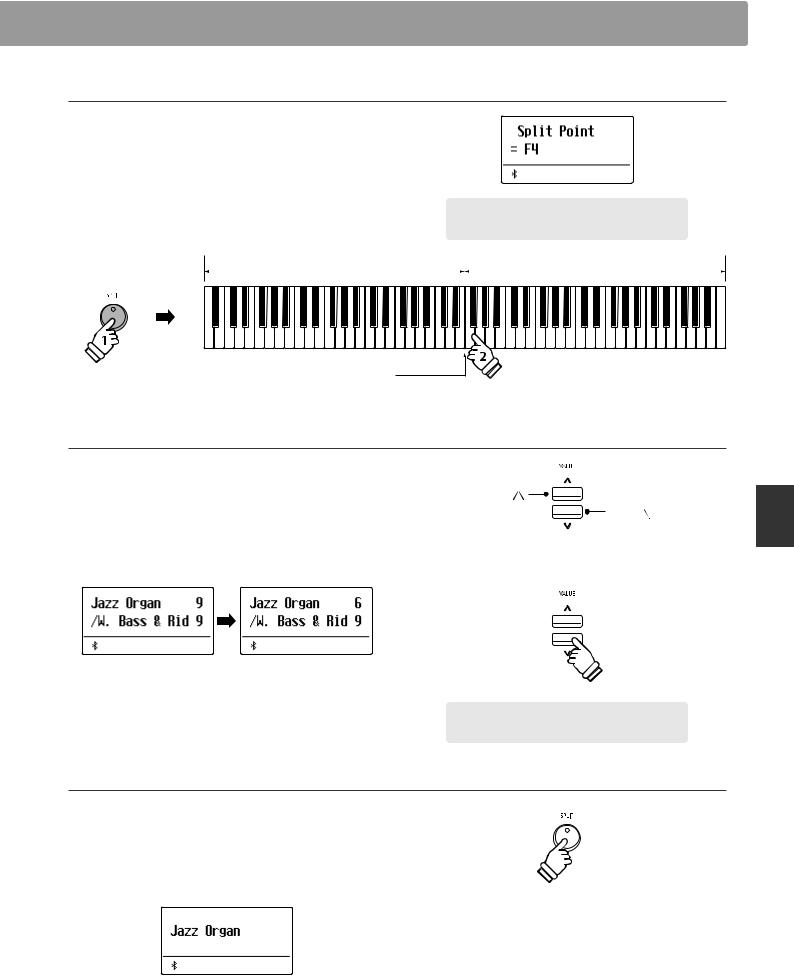
3. Changing the split point
Press and hold the SPLIT button, then press the desired split key on the keyboard.
The name of the pressed key will briefly be shown in the display, and will become the new split point.
* Split Mode and the Rhythm Section share the same split point.
Example: To set the split point to key F4, press and hold the SPLIT button, then press the F4 key.
Lower section |
Upper section |
|
|
|
|
|
|
|
hold
New split point
4. Adjusting the upper/lower sound volume balance
While Split mode is in use:
Press the  or
or  VALUE buttons to adjust the volume balance between the upper and lower sections.
VALUE buttons to adjust the volume balance between the upper and lower sections.
The volume balance will briefly be shown in the display.
*The default Split mode volume balance is 9-9.
*The preferred Split mode upper/lower volume balance can also be stored to a Registration memory for convenient recall. Please refer to page 36 for more information.
VALUE |
|
Increase upper |
VALUE |
section volume/ |
Increase lower |
decrease lower |
section volume/ |
section volume. |
decrease upper |
|
section volume. |
4 ×
Example: To decrease the volume of the upper section sound to 6, press the VALUE button four times.
button four times.
5. Exiting Split mode
While Split mode is in use:
Press the SPLIT button.
The LED indicator for the SPLIT button will turn off, and the instrument will return to normal (full keyboard) operation.
Basic Operation
21
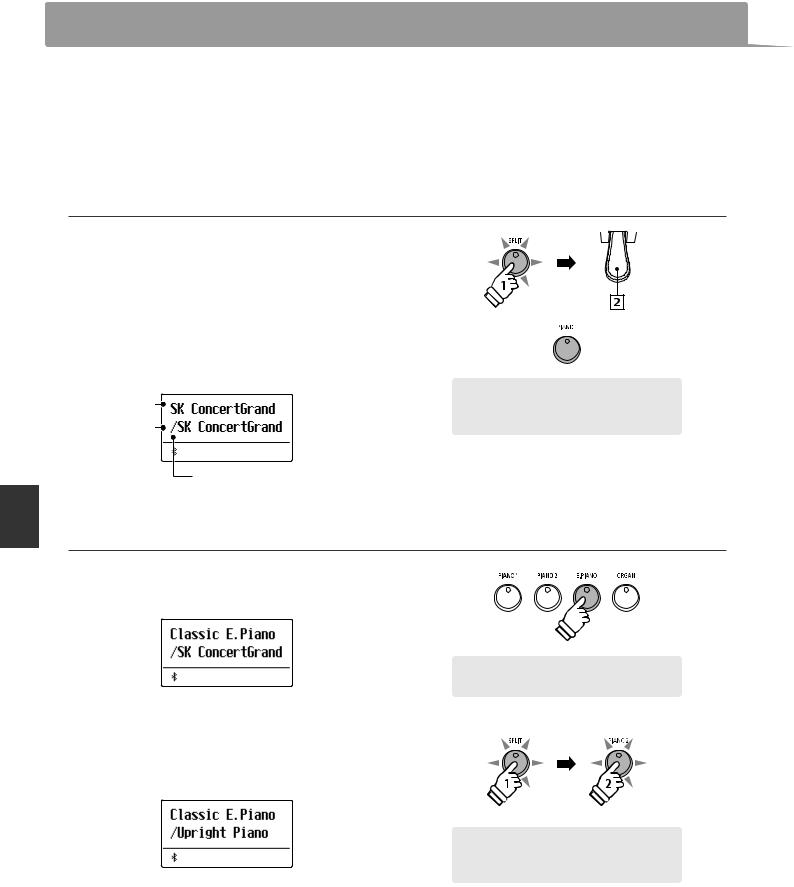
Basic Operation
FourHandsHandsModeMode
The Four Hands Mode function divides the keyboard into two sections in a similar way to that of the Split Mode function. However, with Four Hands Mode enabled, the octave/pitch of each section is automatically adjusted to create two separate 44-key instruments with the same playing range. This function is intended to allow two people to practise together or perform piano duets using a single instrument.
1. Entering Four Hands mode
Press and hold the SPLIT button, then press the damper pedal.
The LED indicator for the SPLIT button will start to flash to indicate that Four Hands mode is in use.
* The default four hands mode split point is set between keys E4 and F4. |
hold |
|
|
Press the |
|
||||
|
|
|
|
damper pedal |
|
|
|
|
The LED indicator for the PIANO1 button will turn on, and the“SK ConcertGrand”sound will automatically be selected for both the upper and lower sections.
Upper section |
Default Four Hands mode: |
sound |
The “SK ConcertGrand” sound is selected for both |
Lower section |
the upper and lower sections. |
|
|
sound |
|
Four Hands enabled
2. Changing the upper/lower section sounds
To select a different sound for the upper section:
Press the desired SOUND button.
To select a different sound for the lower section:
Press and hold the SPLIT button, then press the desired SOUND button.
*If the included F-10H foot pedal is connected to the instrument, the pedal will function as a damper pedal for the upper section only. However, if the optional GFP-3 or F-302 triple pedal is connected, the right (sustain) and left (soft) pedals will function as independent damper pedals for the upper and lower sections respectively.
*Preferred Four Hands mode upper/lower sound combinations can be stored to a Registration memory for convenient recall. Please refer to page 36 for more information.
Example: To select the “Classic E.P.” sound for the upper section, press the E.PIANO button.
hold |
2 |
|
× |
Example: To select the “Upright Piano” sound for the lower section, press and hold the SPLIT button, then press the PIANO2 button twice.
22
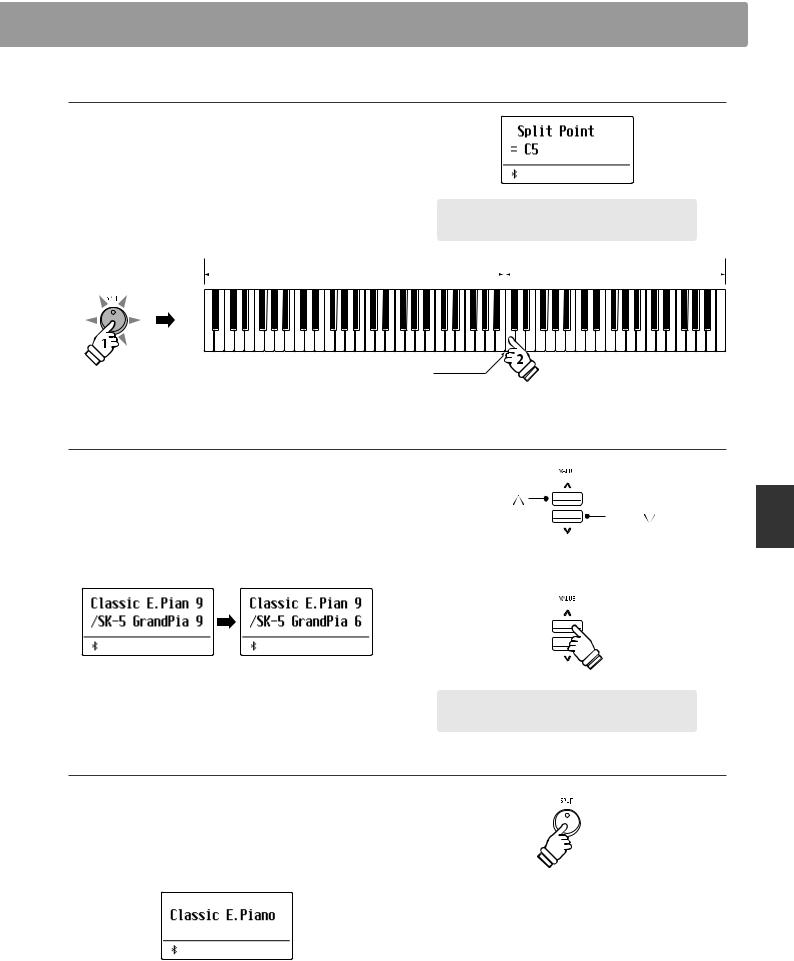
3. Changing the Four Hands mode split point
Press and hold the SPLIT button, then press the desired split key on the keyboard.
The name of the pressed key will briefly be shown in the display, and will become the new Four Hands mode split point.
Example: To set the split point to key C5, press and hold the SPLIT button, then press the C5 key.
Lower section |
|
Upper section |
|
|
|
|
|
|
|
|
|
hold |
New split point |
|
4. Adjusting the upper/lower sound volume balance
While Four Hands mode is in use:
Press the  or
or  VALUE buttons to adjust the volume balance between the upper and lower sections.
VALUE buttons to adjust the volume balance between the upper and lower sections.
The volume balance will briefly be shown in the display.
*The default Four Hands mode volume balance is 9-9.
*The preferred Four Hands mode upper/lower volume balance can also be stored to a Registration memory for convenient recall. Please refer to page 36 for more information.
VALUE |
|
Increase upper |
VALUE |
section volume/ |
Increase lower |
decrease lower |
section volume/ |
section volume. |
decrease upper |
|
section volume. |
4 ×
Example: To decrease the volume of the lower section sound to 6, press the VALUE  button four times.
button four times.
5. Exiting Four Hands mode
While Four Hands mode is in use:
Press the SPLIT button.
The LED indicator for the SPLIT button will stop flashing, and the instrument will return to normal (full keyboard) operation.
Basic Operation
23
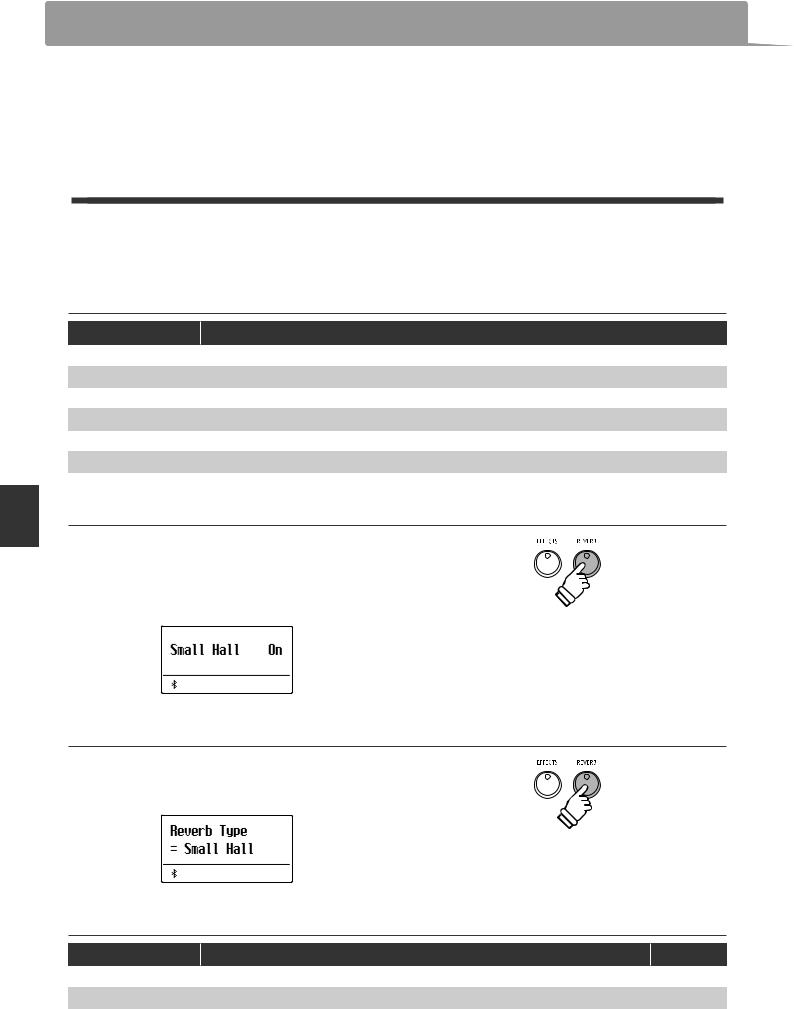
Basic Operation
Enhancingthe Soundthe Sound
The ES920 digital piano offers a variety of features to adjust and enhance the character of a particular sound. Some of these features (e.g. Reverb), are enabled automatically when a sound is selected, however players may also wish to change the strength or type of enhancement to suit their personal preferences or different styles of music.
1 Reverb
Reverb adds reverberation to the sound, simulating the acoustic environment of a recital room, stage, or concert hall. Some sound types, such as acoustic piano, enable reverb automatically in order to improve acoustic realism. The ES920 digital piano features six different reverb types.
Reverb types
Reverb type |
|
Description |
Room |
|
Simulates the ambiance of a small rehearsal room. |
|
||
Lounge |
|
Simulates the ambience of piano lounge. |
Small Hall |
|
Simulates the ambiance of a small hall. |
Concert Hall |
|
Simulates the ambiance of a concert hall or theater. |
Live Hall |
|
Simulates the ambiance of a live hall or stage. |
Cathedral |
|
Simulates the ambiance of a large cathedral. |
|
|
|
1. Turning Reverb on/off
Press the REVERB button to turn reverb on/off.
The LED indicator for the REVERB button will turn on to indicate when reverb is in use, and the current status will briefly be shown in the display.
2. Entering the Reverb settings menu
Press and hold the REVERB button.
The reverb settings menu will be shown in the display.
hold
Reverb settings
Reverb setting |
|
Description |
|
Range |
Type |
|
Changes the type of environment. |
|
– |
|
|
|||
Depth |
|
Adjusts the depth of the environment (i.e. amount of reverberation to apply). |
|
1~10 |
Time |
|
Adjusts the decay length/speed of the reverberation. |
|
1~10 |
|
|
|
|
|
24
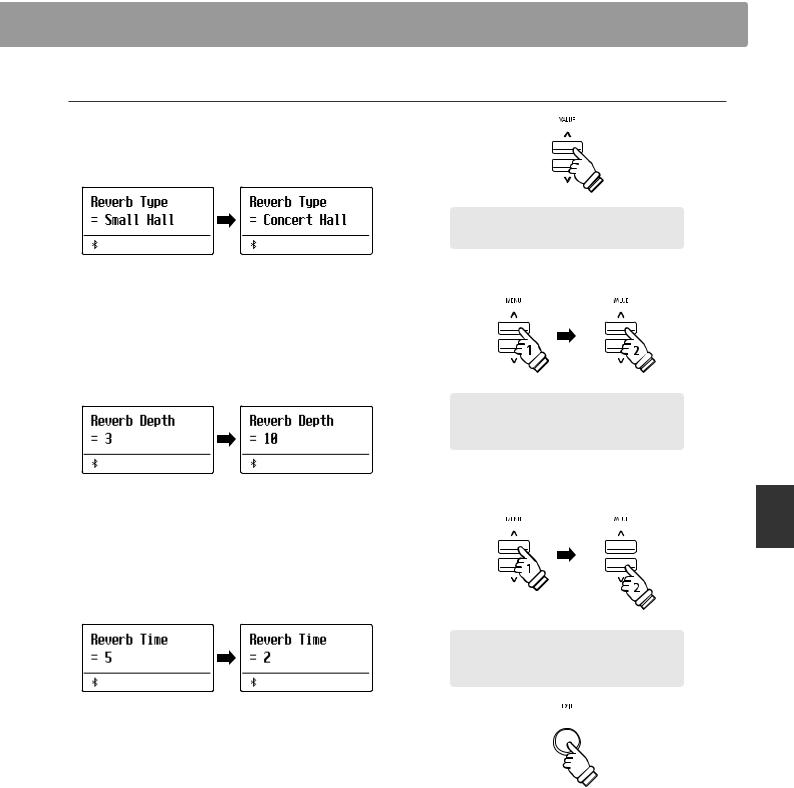
3. Adjusting the Reverb settings (type/depth/time)
While the reverb settings menu is shown, to change the reverb type:
Press the  or
or  VALUE buttons to cycle through the different reverb types.
VALUE buttons to cycle through the different reverb types.
To change the reverb depth:
Press the  or
or  MENU buttons to select the “Reverb Depth” page, then press the
MENU buttons to select the “Reverb Depth” page, then press the  or
or  VALUE buttons to decrease or increase the reverb depth setting.
VALUE buttons to decrease or increase the reverb depth setting.
* The reverb depth setting can be adjusted within the range of 1~10.
To change the reverb time:
Press the  or
or  MENU buttons to select the “Reverb Time” page, then press the
MENU buttons to select the “Reverb Time” page, then press the  or
or  VALUE buttons to decrease or increase the reverb time setting.
VALUE buttons to decrease or increase the reverb time setting.
* The reverb time setting can be adjusted within the range of 1~10.
To exit the reverb settings menu and return to normal playing mode, press the EXIT button or wait 10 seconds.
*Reverb settings are independent for each sound variation.
*Any changes made to the reverb type, settings, or on/off status will remain until the power is turned off.
*Preferred reverb settings can be stored to a Registration memory for convenient recall. Please refer to page 36 for more information.
Example: To change the reverb type from “Small Hall” to “Concert Hall”, press the VALUE  button.
button.
hold
Example: To increase the reverb depth, press the MENU  button to select the “Reverb Depth” page, then press and hold the VALUE
button to select the “Reverb Depth” page, then press and hold the VALUE  button.
button.
hold
Example: To reduce the reverb time, press the MENU  button to select the “Reverb Time” page, then
button to select the “Reverb Time” page, then
press and hold the VALUE  button.
button.
Basic Operation
25
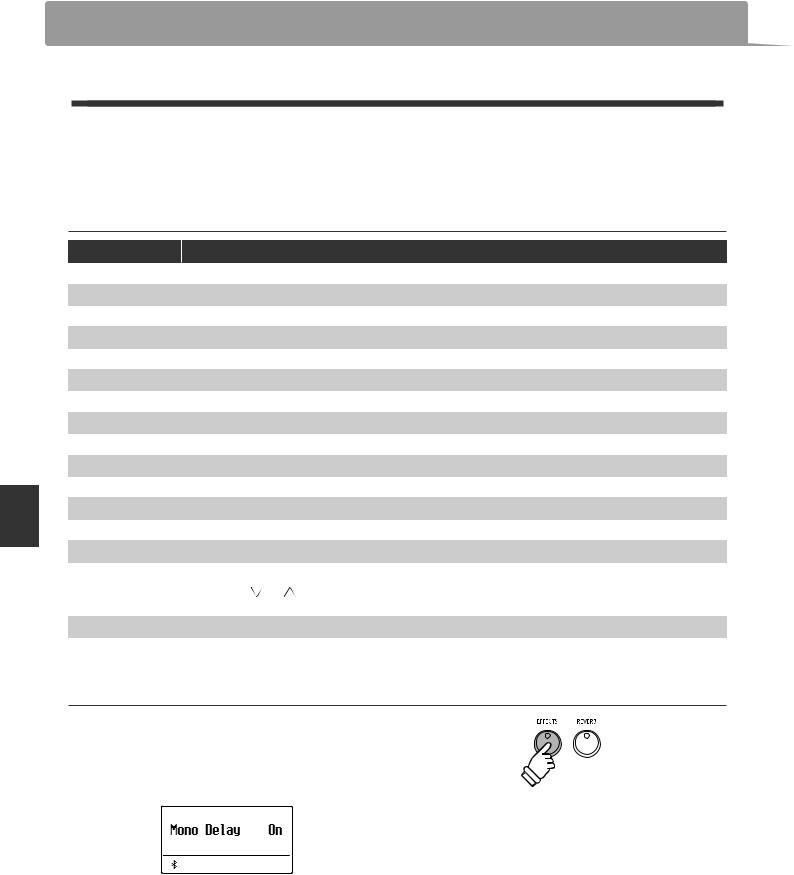
Basic Operation
Enhancing the Sound
2 Effects
In addition to reverb, various other effects can be applied to the selected sound, altering the tonal character and feeling of the instrument. As with reverb, some sound types enable certain effects automatically in order to enhance tonal quality. The ES920 digital piano features 16 different effect types.
Effect types
Effect type |
|
Description |
Mono Delay |
|
Adds an echo effect to the sound, playing through both speakers (stereo) simultaneously. |
|
||
Ping Delay |
|
Adds a “ping pong” echo effect to the sound, giving the impression that it is “bouncing” from left to right. |
Triple Delay |
|
Similar in principle to Ping Delay, but with an additional centre echo. |
Chorus |
|
Layers a slightly detuned version of the sound over the original, thus enriching its tonal character. |
Classic Chorus |
|
Similar in principle to Chorus, but intended for vintage electric piano sounds. |
Ensemble |
|
Enriches the sound by adding three voiced chorus. |
Tremolo |
|
Adds a tremor to the sound by varying the volume constantly. |
Classic Tremolo |
|
Similar in principle to Tremolo, but intended for vintage electric piano sounds. |
Vibrato Tremolo |
|
Adds vibrato to tremolo. |
Auto Pan |
|
Alternates the sound output from left to right across the stereo field using a sine wave. |
Classic Auto Pan |
|
Similar in principle to Auto Pan, but intended for vintage electric piano sounds. |
Phaser |
|
Applies a cyclic phase change to the sound, giving the impression that the sound is moving. |
Classic Phaser |
|
Adds an effect produced by digital signal processing of classic chorus. |
Compressor |
|
Increases the acoustic pressure. |
|
|
Simulates the sound of a rotary speaker commonly used with vintage electronic organs. |
Rotary 1 |
|
* Pressing the and MENU buttons simultaneously alternates the speed of the rotary simulation between “Slow” |
|
|
and “Fast” effect modes. If the optional GFP-3 or F-302 pedal is connected, the left (soft) pedal can also be used. |
Rotary2 |
|
Adds vibrato to the rotary speaker effect. |
|
|
|
1. Turning Effects on/off
Press the EFFECTS button to turn effects on/off.
The LED indicator for the EFFECTS button will turn on to indicate when effects are in use, and the current status will briefly be shown in the display.
26
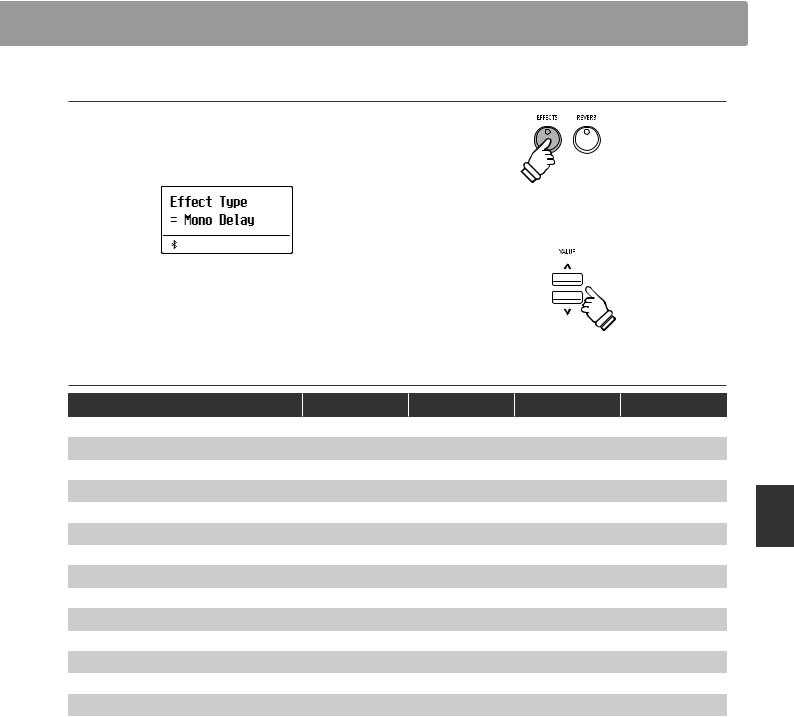
2. Entering the Effects settings menu, selecting the Effect type
Press and hold the EFFECTS button.
The first page of the effects settings menu will be shown in the display.
hold
Press the  or
or  VALUE buttons to cycle through the different effect types.
VALUE buttons to cycle through the different effect types.
Effect settings
Effect type |
|
Setting 1 |
|
Setting 2 |
|
Setting 3 |
|
Setting 4 |
Mono Delay / Ping Delay / Triple Delay |
|
Dry / Wet |
|
Time |
|
Feedback |
|
High Damp |
|
|
|
|
|||||
Chorus |
|
Dry / Wet |
|
Speed |
|
Feedback |
|
Depth |
Classic Chorus |
|
Mono / Stereo |
|
Speed |
|
– |
|
– |
Ensemble |
|
Dry / Wet |
|
Speed |
|
– |
|
– |
Tremolo |
|
Dry / Wet |
|
Speed |
|
– |
|
– |
Classic Tremolo |
|
Dry / Wet |
|
Speed |
|
– |
|
– |
Vibrato Tremolo |
|
Dry / Wet |
|
Speed |
|
– |
|
– |
Auto Pan |
|
Dry / Wet |
|
Speed |
|
– |
|
– |
Classic Auto Pan |
|
Dry / Wet |
|
Speed |
|
– |
|
– |
Phaser |
|
Dry / Wet |
|
Speed |
|
Feedback |
|
Depth |
Classic Phaser |
|
Dry / Wet |
|
Speed |
|
Feedback |
|
Depth |
Compressor |
|
Gain |
|
Ratio |
|
Threshold |
|
Attack |
Rotary 1 |
|
Accel. Speed |
|
Rotary Speed |
|
Lower Slow Speed |
|
Upper Slow Speed |
Rotary 2 |
|
Accel. Speed |
|
Rotary Speed |
|
Vibrato/Chorus |
|
Spread |
|
|
|
|
|
|
|
|
|
Basic Operation
27
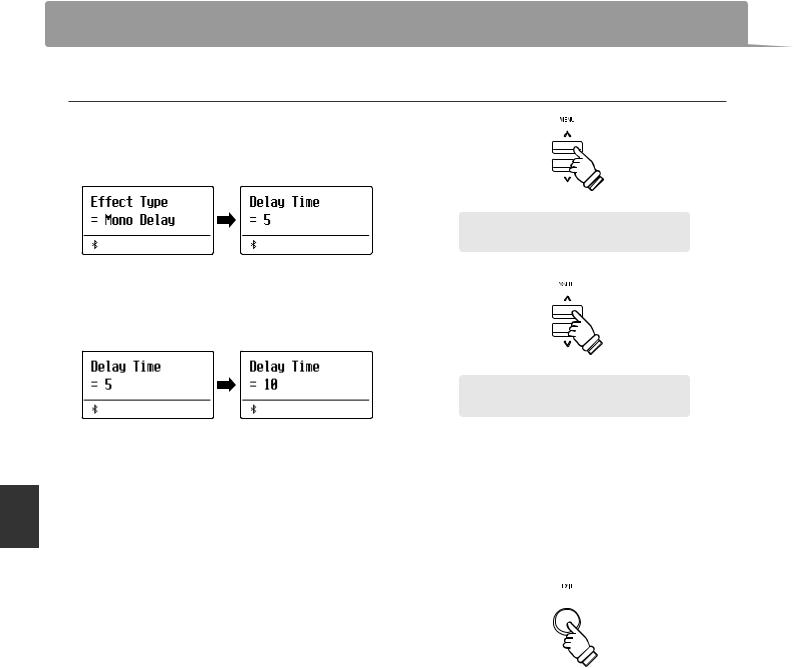
Basic Operation
Enhancing the Sound
3. Selecting and adjusting the Effect settings
While the effects settings menu is shown in the display:
Press the  or
or  MENU buttons to cycle through the different effects settings pages.
MENU buttons to cycle through the different effects settings pages.
2 ×
Example: To select the “Delay Time” effects setting, press the MENU  button twice.
button twice.
Press the  or
or  VALUE buttons to adjust the value of the selected effects setting.
VALUE buttons to adjust the value of the selected effects setting.
hold
Example: To increase the “Delay Time” effects setting, press and hold the VALUE  button.
button.
*Effect settings can be adjusted within the range from 1 to 10 except Compressor and Rotary 2(Vibrato/Chorus).
*Compressor settings are as follows.
Gain (1 - 128)
Ratio (1:1 - 64.5:1)
Threshold (1 - 128)
Attack (1 - 128)
*Rotary 2(Vibrato/Chorus) settings are as follows.
Vibrato (V-1 ~ V-3)
Chorus (C-1 ~ C-3)
To exit the effects settings menu and return to normal playing mode, press the EXIT button or wait 4 seconds.
*Effects settings are independent for each sound variation.
*Any changes made to the effect type, settings, or on/off status will remain until the power is turned off.
*Preferred effects settings can be stored to a Registration memory for convenient recall. Please refer to page 36 for more information.
28

3 Amp Simulator
The ES920’s Amp Simulator (Amp Sim) attempts to reproduce the sound, response, and overdrive characteristics of a typical amp/speaker combination, giving electric piano and drawbar organ sounds an authentic vintage quality. Once enabled, the amplifier type can be selected, with adjustable drive, level, and Low/Hi EQ settings. As with the Reverb and Effects functions, selecting certain sounds will enable the Amp Sim automatically.
1. Turning the Amp Sim on/off
Press the AMP button to turn the Amp Sim on/off.
*If Dual or Split/Four Hands modes are selected, the Amp Sim will not affect the layered or lower section sounds.
Amp Sim settings
Amp Sim setting |
|
Description |
|
Range |
Type |
|
Selects the amplifier/speaker type. |
|
See below |
|
|
|||
Drive |
|
Adjusts the drive (overdrive) level of the selected amplifier. |
|
1~10 |
Level |
|
Adjusts the volume level of the selected amplifier. |
|
1~10 |
EQ Low |
|
Adjusts the low frequency EQ level of the selected amplifier. |
|
–6 dB~+6 dB |
EQ High |
|
Adjusts the high frequency EQ level of the selected amplifier. |
|
–6 dB~+6 dB |
|
|
|
|
|
2. Changing the Amp Sim type
While the Amp Sim settings menu is shown in the display:
Press and hold the AMP button. The Amp Sim settings menu will be shown in the display.
hold
Press the  or
or  VALUE buttons to cycle through the different
VALUE buttons to cycle through the different
Amp Sim types.
Basic Operation
Amp Sim types
Amp Sim type |
|
Description |
S. Case I |
|
A distantly miked suitcase type speaker, suitable for vintage electric piano sounds. |
|
||
S. Case II |
|
A closely miked suitcase type speaker, suitable for vintage electric piano sounds. |
L. Cabinet |
|
A speaker enclosed within a wooden cabinet, suitable for vintage drawbar organ sounds. |
|
|
|
29
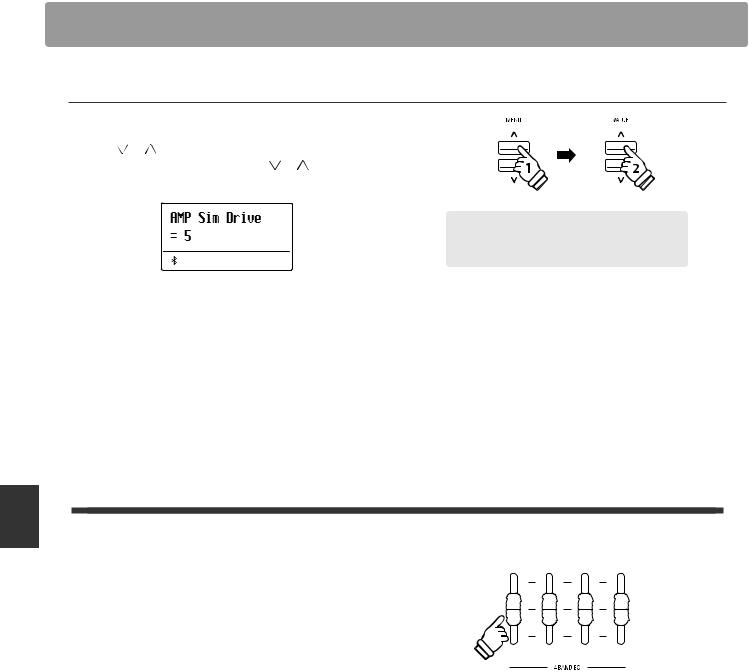
Basic Operation
Enhancing the Sound
3. Adjusting the Amp Sim settings (drive/level/eq low/eq high)
While the Amp Sim settings menu is shown in the display:
Press the or MENU buttons to cycle through the different Amp Sim settings pages, then press the or VALUE buttons to adjust the value of the selected Amp Sim setting.
To exit the Amp Sim settings menu and return to normal playing mode, press the EXIT button or wait 4 seconds.
*Amp Sim settings are independent for each sound variation.
*Any changes made to the Amp Sim type, settings, or on/off status will remain until the power is turned off.
*Preferred Amp Sim settings can be stored to a Registration memory for convenient recall. Please refer to page 36 for more information.
hold
Example: To increase the drive of the Amp Sim, press the MENU  button to select the “Amp Sim Drive” page, then press and hold the VALUE
button to select the “Amp Sim Drive” page, then press and hold the VALUE  button.
button.
4 Equaliser
The Equaliser allows the volume of Low, Mid-low, Mid-high, and High frequency bands to be adjusted in real-time.
From the leftmost slider, volume of “Low”, “Mid-low”, “Mid-high”, and “High” frequencies can be adjusted.
The 4-band equalizer can be set by Tone Control. (page 74)
Tone Control offers 8 preset types and user EQ. Settings made in
Tone Control have effects on 4 sliders on the panel.
The volume range is from -6dB to +6dB; therefore, the volume may not change even when the slider is moved in some cases depending on the Tone Control settings.
For example, if the volume is set to +6dB in Tone Control, the volume does not increase when the slider is moved above the middle. Meanwhile, the volume decreases if the slider is moved below the middle.
The volume set in Tone Control applies when the slider is at the middle.
30
